
Centar savremene umjetnosti Crne Gore / Contemporary Art Centre of Montenegro Dvorac Petrovića / 14. mart - 14. aprila 2019. / March 14 th – April 14 th 2019
Izložba „4/prostor 4” predstavlja crnogorskoj publici četvoricu značajnih umetnika: Srđana Apostolovića, Zdravka Joksimovića, Dobrivoja Krgovića i Dušana Petrovića. Njihova saradnja datira od kraja 80-ih godina XX veka kada su se okupili pod okriljem Likovne radionice galerije Studentskog kulturnog centra u Beogradu od tad, pa sve do današnjeg dana, oni se konstantno druže, razmenjuju ideje, iskustva razmišljanja o umetnosti, međusobno pomažu i sarađuju u okviru različitih zajedničkih projekata. Poredeći njihove domete sa Novom britanskom skulpturom , likovna kritika daje im naziv pod kojim su do dan danas poznati u stručnoj literaturi - Nova beogradska skulptura . Njihove prve zajedničke i samostalne izložbe u beogradskom Studentskom kulturnom centru (SKC) protiču u znaku istraživanja različitih vidova kreativnog izražavanja (kao što su minimalizam, arte povera , skulptura u proširenom polju). I tada, kao i danas, njihov umetnički izraz povezuje isti odnos prema vrhunskoj estetizaciji forme poštovanju prirode materijala, sklonost ka preformulaciji i rekontekstualizaciji, kao naglašen intelektualni pristup pri stvaranju umetničkog dela. Ipak, svaki od ove četvorice umetnika je izraziti individualista, snažna kreativna ličnost karakterističnog umetničkog senzibiliteta. Njihove zajedničke izložbe izuzetno su zanimljive jer predstavljaju retku priliku da na istom mestu, jedne uz druge, vidimo radove ovih umetnika na taj način nam pružaju mogućnost ispravnije percepcije njihovih međusobnih uticaja koji često ostanu nedovoljno vidljivi, neiščitani negde u dubljim slojevima umetničkog dela.
Do sredine 90-ih godina, SKC im omogućuje niz zajedničkih izložbi u okviru tadašnje države (Beograd, Zagreb, Dubrovnik, Sarajevo), ali i u inostranstvu (Pariz, Strazbur, Bari, Lisabon, Budimpešta), što svedoči o neverovatnom uspehu i umetničkom zamahu ovih, tada mladih umetnika, uspehu koji prekida rat sveopšta kriza 90-ih godina.
Iako tokom druge polovine 90-ih godina svaki od njih kreće svojim umetničkim putem, oni ne prestaju da se intenzivno druže i sarađuju. Prva zajednička izložba koja je posle skoro dve decenije pauze u zajedničkim izlaganjima organizovana 2011. godine u Kući legata u Beogradu, imala je snažan odjek i kod publike kod likovne kritike. Sledeću, takođe izuzetno uspešnu zajedničku izložbu, umetnici organizuju u prostoru Zenit 4 u Novim Banovcima 2015. godine, da bi krajem 2018. odlučili da se novim izložbama u okviru kojih izlažu dominantno nove radove, predstave i publici u regionu.
Srđan Apostolović - želja za savršenim oblikom
Srđan Apostolović izlaže radove koji se uglavnom odnose na visoko estetizovane forme elemenata karakterističnih za enterijere koje autor pretvara u autonomna umetnička dela. „Nameštaj” (koji to u stvari nije), „grejalicu” i preformulisane delove drvenih vrata, umetnik postavlja u drugačiji kontekst kroz uspostavljanje potpuno novog međusobnog odnosa elemenata, ali njihovog odnosa sa okolnim prostorom, omogućavajući im alternativni modus vivendi i modus operandi kroz širok spektar potencijalnih relacionih značenja.
Zidna instalacija Multi perfect sastoji se od drvenih elemenata koji evociraju profilisane delove starinskih vrata. Apostolović je na svakom elementu izvršio umetničku intervenciju prelamajući njegovu površinu pod različitim uglovima da bi dobio efekat „iskrivljenih ogledala” ili prelamanja slike u vodi. Umetnik je 2015. godine izveo sličnu instalaciju, tada u podnoj varijanti sastavljenoj od većeg
broja elemenata. Brojni načini manipulisanja postavke elemenata u okviru instalacije Multi perfect (njihovo ređanje, pomeranje, izbor smera uglova prostiranja) otvara mnogobrojne mogućnosti usaglašavanja instalacije datog prostora. Naziv rada izveden je iz advertajzing komunikacije.
4x više snage naziv je poliptiha koji se sastoji od četiri rada jednakih dimenzija izrađnih tehnikom inkrustacije/intarzije furnira u papir. Radovi se mogu izlagati i pojedinačno, ali ovom prilikom umetnik se opredelio da ih predstavi u vidu autonomne celine u formi tetraptiha. Idejni osnov koji povezuje ove četiri varijacije na istu temu je likovnost početaka gejming kulture 80-ih godina XX veka. Apostolović kroz umetnički postupak modifikuje karakteristično prostiranje crteža pod uglovima od 45 90 stepeni, stvarajući nove imaginativne motive. Plemenitost furnira, oštri geometrijski obrisi i belina papira stvaraju zanimljivu kompoziciju u kojoj je dinamika pravaca prostiranja intarzija u ravnoteži sa smirenom belinom pozadine. Naziv rada reflektuje savremeni marketinški žargon.
Pauza u ponavljanju (Break in Repetition) predstavlja jednu od mogućih varijacija umetničke instalacije kao produkta umetnikovog eksperimentisanja u okviru kombinovanja dva različita elementa nastala u vremenskom rasponu od 20 godina. Naziv rada ukazuje na nebrojeno mnogo različitih kreativnih načina kombinovanja ovih objekata. Stolicu, čije je sedište napravljeno od crne perforirane gume otirača za noge, Apostolović pozicionira u prostor okrenuvši je naopako, otkrivajući posmatraču donji deo, drvenu konstrukciju sa nogama koje streme uvis. Drugačiji ugao posmatranja, stvaranje alternativne situacije ne narušava likovnu meru, već doprinosi likovnoj atraktivnosti i vizuelnoj usaglašenosti objekata. Ova struktura vizuelno se nadovezuje na objekat u formi polukalote koji je delimično pokriva – „školjku” definisanu punim i praznim delovima - trakama lepljenog hrastovog furnira njihovim međusobnim razmacima. Iako forma pravougaone konstrukcije stolice predstavlja antipod lučno oblikovanom furniru polukalote, spaja ih istovetni kolorit drveta hrasta. Senke koje oba elementa stvaraju pod osvetljenjem čine integralni deo vizuelne percepcije instalacije.
Rad Willkommen u sebi nosi iskustvo redi-mejda pop-arta. Apostolović je iskoristio originalnu starinsku aluminijumsku grejalicu za kupatilo na kojoj je izvršio intervenciju, zamenivši pravi grejač neonskom cevi koja svetli veoma sličnom crvenom bojom kao sam grejač. Umetnik rad dopunjuje igrom u nazivu koji se može shvatiti bukvalno, kao topla dobrodošlica, ali ujedno kao ironičan poziv jer grejalica može i da opeče.
Ne mrzim površno – prostorna instalacija od četiri elementa – okruglog klub-stola, klupe, komode sa previsokim nogama i predimenzioniranog dvoseda od španske trske i drveta. Iako nam na prvi pogled izgleda kao običan nameštaj, u sledećem trenutku shvatamo da nešto „ne štima”; dimenzije raspored su „pogrešni”, „neodgovarajući”. Srđan Apostolović, na svom velikom iskustvu bavljenja unutrašnjim dizajnom, rekontekstualizuje namenu, interveniše u proporcijama oblika, postavlja elemente u nove relacije stvara umetničku instalaciju autonomne logike i postojanja. U instalaciju uključuje sijalicu na kablu minimalistički redukovanog dizajna kojom odozgo osvetljava najmanji element – klub-sto, akcentujući ga dovodeći u ravnotežu sa ostatkom postavke. Drugi detalj je uramljeni kvadrat od španske trske postavljen na dvosed sa jedva vidljivim natpisom “HILFE” („upomoć” na nemačkom jeziku) koji osikava umetnikov humor kao reakciju na nedoumice tokom kreativnog procesa nastajanja ove instalacije.
Apostolovićev istančan odnos prema površini, formi, materijalima i boji doprinosi vizuelnoj atraktivnosti njegove umetničke prakse. Njegov nepogrešiv osećaj za meru likovnosti različito definisanih površina i dimenzija dovodi do toga da insistira na apsolutnoj čistoći jasnoj definisanosti forme.
Srđan Apostolović priča priču oblicima, ritmom definisanosti površina, bojom, taktilnošću pažljivo usaglašenim odnosima elemenata kompozicije. Iako su nosioci narativa, njegovi radovi deluju autoreferentno, jer su do te mere dovedeni do perfekcije da ih sam taj kvalitet savršenstva pretvara u
umetnički entitet za sebe. Dvosmisleni nazivi radova, u isto vreme bukvalni ironični, ističu značaj ugla jezika vizuelnog pripovedanja umetnika ukazuju na istovremeno postojanje „obične” i inverzne realnosti njegovih radova.
Apostolović postavlja objekte u prostor uzimajući u obzir njegove osobine, kao osobine objekta; rad je postavljen tek kad postigne sadejstvo prostora objekta na način koji pruža dodatni kvalitet, težeći postmodernističkom Gesamtkunstwerk-u .
Zdravko Joksimović - “Nema previše mistifikacije, to što je pred vama, to su znaci koje odgonetamo svakodnevno i vrlo lako iščitavamo”
Ponekad oštar, ali nikad brutalan, Zdravko Joksimović je fokusiran analitičan umetnik. Poznat je po preispitivanju različitih kombinacija u kojima slobodno vizuelno povezuje pojmove i integriše ih kroz metaforičko-metonimijske pristupe (stilske figure koje reči koriste u prenesenom značenju, a koje za početni pojam vezuje sličnost, kao kod metafore, ili logika, u slučaju metonimije). Joksimovićevi radovi takođe su svojstvenii po duhovito-zagonetnim nazivima, jednako bitnim za percepciju njegove umetničke prakse. U okviru izložbe 4/prostor 4 umetnik izlaže dva starija i tri nova rada. Upečatljive kombinacije boja i materijala, kao i njegova vrhunska obrada, predstavljaju specifičnosti Joksimovićeve umetničke prakse još od njenih početaka.
Sad se sve vidi , rad iz 2012. godine, predstavlja Joksimovićevu umetničku viziju slamčice u čaši sa tečnošću. Drvenu „slamčicu” vizuelno možemo podeliti na četvrtine: gornja čevrtina blago je zakošena i spojena sa sledećom cik-cak harmonikom oštrih uglova; donja četvrtina, nežno talasasta, oslikava vizuelno prelamanje predmeta u tečnosti. Gornji deo “slamčice” umetnik definiše geometrijskom oštrinom, dok donji transformiše u meku, vijugavu formu. Oblu, bokastu „čašu” Joksimović prikazuje u preseku sa konveksnom unutrašnjom (prednjom) i konkavnom spoljnom (zadnjom) stranom; telo „čaše” fragmentovano je fugama u beloj i boji cigle koje se sustiču pod pravim uglovima. Formalistički gledano, svaki deo je osmišljen da ima svoju suprotnost sa kojom ostvaruje elegantnu, nenametljivu ravnotežu.
Rad Sad se sve vidi prikazuje ogoljavanje istine, pogled iznutra na to kako stvari zaista funkcionišu konfrontirajući pred posmatračem privid i stvarnost.
1000 puta zato (2015. godina) otkriva nam segment stilizovane metalne „kičme” na drvenoj podlozi u obliku violončela roze boje. Sirovost neobrađenih ivica rada, intenzivnost roze nijanse i užljebljenost prave „kičme” otvaraju mogućnost različitim načinima iščitavanja, prikrivene narativne poetike.
Rad Na mene uvek možeš da se osloniš nastao krajem 2018. godine, predstavlja spoj apstraktne skulpturalne drvene forme kockastog postolja od tamnog metala dobijenog savijanjem metalnog lima. Sve je pomalo pomereno – oblici i spojevi, pozicioniranje objekta na postolje, kao i samo postolje. Izgleda kao da sve napeto stoji u jedinom mogućem položaju koji obezbeđuje stanje kakve-takve, labilne ravnoteže, te da ga i najmanje pomeranje može izbaciti iz ovog krhkog balansa i dovesti do njegovog urušavanja. Ova spoznaja tenzije između onoga šta se može desiti iščekivanja da li će se zaista i dogoditi, suvereno drži posmatračevu pažnju prikovanom za izloženi objekat.
Ni početka ni kraja naziv je zidnog rada izvedenog od gume crvene i zelene boje, isečene na trake krivolinijskih obrisa koje se međusobno uklapaju. Umetnik izdiže zelene površine iznad ravni crvene gume, dobijajući na taj način mogućnost da oboji konturu i istakne njen linijski kvlitet. Iako na
prvi pogled ovaj potpuno apstraktan rad deluje kao igra forme kolorita, Ni početka ni kraja zapravo predstavlja odu liniji, njenom uzbudljivom ritmu i izražajnim mogućnostima koje nam pruža.
U radu Živa ograda Zdravko Joksimović se opredeljuje za metal gumu kao izbor materijala. Sivo naličje gume čini bazu, odnosno pozadinu celokupne zidne kompozicije, dok zelena guma izviruje ispod zakrivljenih linija opsecanja graviranja elaboriranog metalnog lima. Pojedini ovalni delovi zasečenog metala izbačeni u polje senka koju metalni lim baca na zelenu i sivu gumenu podlogu doprinose sofisticiranoj valerskoj gradaciji kompozicije, dok detalj u vidu perceta ciklama boje razigrano razbija smiren kolorit.
Radovi Ni početka ni kraja i Živa ograda iz 2018. godine predstavljaju nastavak umetnikovih istraživanja podstaknutih slikarskom praksom Bore Iljovskog. Za razliku od slika Iljovskog koje nemaju fokus kompozicije, Joksimovićeva Živa ograda ga ima; nazivom dela, Joksimović takođe obezbeđuje referentnost svog rada u odnosu na pojavni svet, kao igru bukvalnog i prenesenog značenja.
Joksimović zadržava jezičku autonomiju i kompleksnost izraza Iljovskog, ali ih transponuje iz dve u tri dimenzije – iz slikarske ravni u skulptorski prostor. U početku suzdržanije ( Ni početka ni kraja ), a kasnije više eksperimentalno slobodnije ( Živa ograda ) Joksimović poseže za postmodernističkim citiranjem autentične likovnosti kompozicija Bore Iljovskog i na tim osnovama gradi originalne, dekorativne ornamentalne formalističke kompozicije prepoznatljivog, njemu svojstvenog senzibiliteta.
Humor, najčešće u vidu ironje tek ponekad sarkazma, predstavlja modus operandi života, ali i umetničke prakse Zdravka Joksimovića. Kao kod dobrog vica u kome kraj nikada nije ono što smo očekivali kao logični nastavak, nazivi Joksimovićevih umetničkih radova otkrivaju nam jednu potpuno novu, neočekivanu, ali pre svega životnu dimenziju njegovog umetničkog izraza.
Iako su nazivi radova bitan deo umetničke prakse ostala tri umetnika, kod Joksimovića oni su skoro krucijalni, jer često bez njih ne bismo bili u mogućnosti da na pravi način percipiramo njegovu vizuelnu poetiku. Zdravko Joksimović smatra da su nazivi radova njihovo „ime i prezime”, drugim rečima – ono što ih definiše.
Kao profesor na FLU, Joksimović je veoma dobro upoznat sa primenom semiotičke teorije na umetničko delo, ali on semiotiku upotrebljava i vizuelno i lingvistički – kombinujući potencijale predmeta, oblika, materijala, kolorita reči koje ih označavaju kao i reči iz naziva rada, izvlači iz njih nova, neočekivana značenja. Umetnička produkcija Zdravka Joksimovića je heterogena impozantna –stvarajući u ciklusima, umetnik vizuelizuje nove ideje, koristi različite pristupe, materijale tehnike sve dok ne zadovolji svoju znatiželju tada prelazi na nove cikluse. Iako se, tokom vremena, Joksimovićeva umetnička praksa žanrovski i formalistički menjala, njegov umetnički senzibilitet ostao je prepoznatljiv.
dva dela: prvi deo čini originalni video zapis bez zvuka slovenačke pogranične policije snimljen termografskom kamerom. Snimak prikazuje horde „belih” ljudskih obrisa kako ubrzano hodaju ili trče ulicama poljima u potpunom mraku, nastojeći da pređu hrvatsko – slovenačku granicu. Krgović je snimak pronašao na 24ur.com, a preuzeo sa You Tube-a, jednog od društvenih medija koji sve više preuzima ulogu legitimnog informativnog servisa. Drugi deo instalacije čini sedam istovetno dizajniranih flip book-ova, „pokretnih slika” sa izabranim sekvencama originalnog videa u trajanju od po 5 sekundi. Na ovaj način, umetnici temu migracija uzimaju kao protonarativ kojim spajaju dva različita načina pokretanja slike iz dva vremenski udaljena perioda, ali koji su povezani logičko – semantičkim vezama. Oni spajaju najsofisticiraniju tehnologiju današnjice (snimak napravljen termografskom kamerom) sa prvom ikada ostvarenom produkcijom pokretne slike (flip book).
Prvi, originalni kontekst snimka je dokumentarano – informativan, namenjen pograničnoj policijskoj kontroli; postavljanje snimka na 24ur.com i You Tube daje video zapisu drugačiji informativni kontekst namenjen široj javnosti o dešavanjima u vezi sa napredovanjem kretanja migranata na granici zemalja Evropske Unije. Već rekontekstualizovanom snimku potresnih događanja umetnici po treći put menjaju kontekst, uključivši ga u autorsku umetničku instalaciju.
Migranti na snimku su potpuno beli, podsećaju na duhove, na ljude kojih nema, koji ne postoje. Tek kada posetilac uzme flip book u ruke započne animiranje slika, migranti, njihovi problemi i sudbine postaju opipljivi, stvarni prisutni to ne negde u dalekom svetu, već tu, pred našim očima. „Napetost koja se javlja pri ovakvom spoju postaje bukvalno opipljiva, budući da se animiranje ovih potresnih slika događa doslovce u rukama samih posmatrača”, kaže umetnik.
Tema migracija prisutna je u radu pod nazivom Migration Pattern koji je umetmik na poziv Centra za grafiku vizuelna istraživanja kreirao za prestižni kalendar 2018. godine. Privučen rezultatima kompjuterskog softvera Circos kreiranog za potrebe grafičke vizuelizacije statističkih podataka, Krgović koristi generisane paterne migracija na kojima interveniše tokom postprodukcije, zadržavajući pri tom relativne odnose pomeranja stanovništva u svetu. U prikazanim celinama dominiraju kružni oblici živih boja koji predstavljaju geo-politički definisane delove kontinenata, lukovi pravce migracija stanovništva dok širine lukova odgovaraju procentualnom učešću svakog geo-političkog entiteta u migraciji. Serija Migration Pattern sastoji se iz pet radova koji prikazuju podatke u vremenskim intervalima od po pet godina, počev od 1990. do 2015. godine. Krgović ni ovde, kao ni u jednom od svojih radova, ne iznosi konačne sudove, ne zatvara formu, već ostavlja otvorenu strukturu unutar koje su moguća različita iščitavanja. Same migracije mogu biti dobrovoljne ili prisilne, ekonomske, emotivne, podstaknute katastrofama, itd. Vizuelno, Migration Pattern se isprva čine “veselo i šareno”, razigrano, čak i previše. Ipak, dužim posmatranjem dolazimo do spoznaje da je reč o veoma sofisticiranoj celini sličnih formi u skoro identičnim kompozicijama čija su potencijalna značenja različita od onih isključivo statističkih, a da je razigranost “eyecatcher” koji prikriva mračniji narativ.
Dobrivoje Krgović – „Eksploatisani izvori ne predstavljaju reprodukovanje već poznatih činjenica, već prostor potencijalno novih narativa i izvore novih značenja.”
Za idejni osnov izloženih radova Dobrivoje Krgović navodi da “uzima pronađene prisvojene audio video zapise koje u obliku dokumentarnih materijalnih tragova izlaže ponovnom iščitavanju I uodnošavanju. Uspostavljene veze”, kako nam dalje kaže umetnik, “ne moraju biti konačne, pre je reč o nedovršenim projektima koji otvaraju nove vizure.”
Night Video , umetnička instalacija nastala u koautorstvu sa Ivanom Krgovićem, sastoji se iz
Iako na prvi pogled Migration Pattern deluju kao antipod instalaciji Night Video (statičnost i bogat kolorit naspram pokreta i monohromije crno-belog), ovi radovi postavljeni u istom prostoru, jedan do drugog, čine promišljenu i sistematski uobličenu vizuelnu celinu.
Lesson 22 „A visit to New York” predstavlja zvučnu instalaciju sastavljenu od pronađenih artefakta iz 60-ih godina XX veka: originalne magnetofonske trake Instituta za strane jezike iz Gospodar Jovanove ulice u Beogradu, magnetofona, mikrofona slušalica, digitalno presnimljene lekcije za učenje engleskog jezika (National Council of Teachers of English – NCTE) i deset starih okruglih zvučnika postavljenih na zid u obliku zvezde petokrake. Umetnik kaže da je “struktura sadržaja Lekcije 22 bazirana na principima audio-lingvalnog metoda učenja stranih jezika koji praktikuje vežbe “drilovanja” vodi poreklo od tzv. “vojnog metoda” (ASTP metod). Integrisani muzički sadržaji u lek
ciji, koji su istovremeno istorijski fragmenti i svojevrsni dokumenti, ostvaruju važnu funkciju uvođenja i upoznavanja sa sistemom kulturnih obrazaca.”
Vizuelni fokus instalacije predstavlja petokraka zvezda na zidu formirana od pravilno postavljenih zvučnika na tačkama lomljenja linije koja ispisuje zvezdu. Umetnik kaže da “mnogostruka simbolika zvezde (pentagrama) nudi mesto otvoreno za različite konceptualizacije čime je ujedno izvor mnoštva potencijalnih narativa.“ Krgović ne upućuje ni na jednu “asocijaciju” kao tačnu – u ovoj „igri” nema tačnih i netačnih odgovora, već samo postoji podsticaj na stvaranje novih mogućih narativa podstaknutih prisustvom rekontekstualizovanih artefakata.
Dobrivoje Krgović najviše se udaljio od umetničkih praksi sa početaka stvaranja ove grupe umetnika u okviru Likovne radionice galerije SKC-a u Beogradu. Kao perfekcionista, on krajnje studiozno metodično osmišljava realizuje svoje radove; upravo njegov rad pod nazivom Skulptura od poda do plafona postao je paradigma umetničke scene Srbije 90-ih godina.
Dušan Petrović - „Trudim se da moji radovi na gledaoca ostave utisak, da deluju kao magnet, a koji utisak – zavisi i od njih i od dela.”
Dušanu Petroviću najviše odgovara rad u prirodnim materijalima - drvetu, kamenu, ali staklu i metalu. On izvlači maksimalni prirodni potencijal svakog od ovih materijala, nezavisno od stepena umetničke intervencije. Bilo da glača drvo sve dok ne počne da podseća na ćilibar ili ga minimalno obrađuje i ostavlja skoro netaknutim. kako bi istakao moć njegove prirodne pojavnosti, umetnik stvara skulptoralnu kompoziciju koja u posmatraču neminovno izaziva snažnu emociju.
U okviru izložbe 4/prostor 4 , Petrović auditorijumu predstavlja tri nova i jedan stariji rad. Kod sva četiri rada, drvo kao materijal ima primaran značaj. Većina likovnih kritičara već je primetila da se njegov umetnički senzibilitet najbolje ispoljava u radu sa drvetom – Petrović je tu „na svom terenu”, razigran, opušten, inventivan inovativan.
Radom Buk iz 2012. godine, umetnik je predstavio rečni brzak izveden od drveta. Ovo nadahnuto prevrednovanje tj. preformulacija jednog prirodnog materijala u drugi, drveta u vodu, rezultira izuzetnom snagom upečatjivošću rada koji kada jednom vidite, zasigurno ga nikad ne zaboravljate.
Ali, Buk nije samo to – on je jedna maštovita slagalica, izvor potencijalno beskrajnog niza različitih kombinacija četiri vrste modula – velikih širokih panjeva, uskih visokih drvenih oblica, kružnica od blind furnira dugačkih talasastih elemenata od politiranog blind furnira. Visoke drvene oblice su ponajviše elaborirani skulptoralni elementi celine; imaju do perfekcije uglačan ispupčen vrh u koji Petrović inkorporira jedva primetan detalj – sićušan polu-dragi kamen koji predstavlja kapljicu vode i povezuje ove elemente sa nazivom rada. Preko centralnog dela oblica umetnik plasira traku svetlijeg valera koja se nastavlja duž bočnih strana, razbijajući monotoniju. Kombinujući obrađene i neobrađene delove, umetnik stvara ritam iščitavanja umetničkog dela. Virtuozno osmišljen, Buk se prilagođava prostoru i trenutnoj inspiraciji umetnika, te je uvek „nov”, svež i drugačiji.
Skulpture Letači I II posvećene su pilotima, braniocima Beograda 1941. Velika skulptura Letači I predstavlja svedenu ljudsku figuru od drveta sekvoje koja podseća na stilizovanu raketu. Kroz namerno vidljive poteze obrade drveta motornom testerom raspoznajemo glavu noge/oslonce ove ljudske figure-rakete. Umetnik je omogućio pogledu posmatrača ulazak u dubinu skulpture, te nam je dopustio da vidimo “život” drveta, negov tok, čvorišta gradaciju boja od tamne kore preko sveltog sloja ispod, do boje mesa iznutra. „Drvo je uvek živo, kao skulptura”, kaže Petrović. Čovek –
raketa stoji sa četiri noge na zemlji, spreman da ispuni svoju dužnost - da se vine u nebesa i nestane. Letači II potpuno su drugačije koncipirana skulptoralna celina od Letača – tri male skulpture letača od različitog bojenog metala (aluminijuma i mesinga) postavljene su na lučnu površinu drveta; gornja strana je uglačana unutrašnja strana drveta, a donja je ostavljena neobrađena, sa korom. Ovaj lučni postament stoji na tri drvene noge, formalno potpuno drugačije artikulisane u odnosu na ostatak kompozicije. Brižljivo obrađeno drvo širih užih delova koji se prelivaju jedan u drugi podseća na kapljice ili vreteno. Četrvrta „noga” je samo naznačena, „visi” sa postamenta ne dopire do tla. Pored ove primarne kompozicije, deo rada čini i podna skulptura od obojenog metala u vidu dva kruga koja se presecaju pod pravim uglom simbolično predstavljaju orbite. Letači II više podsećaju na astronaute na nekoj novoj planeti, oni su na svom „cilju” posle uspešno obavljenog zadatka, u nekom drugom, paralelnom univerzumu, nekoj drugoj dimenziji postojanja.
Plovilo je Petrovićeva postmodernistička interpretacija popularnih slikarskih kompozicija sa brodićem na vodi. Vidimo kutiju/kontejner sa drvenim bočnim stranama, dok su prednja i zadnja strana napravljene od stakla; u kutiju, kao izdvojeni deo realnosti, tj. svet za sebe, umetnik smešta nekoliko staklenih talasastih površina jednu na drugu (voda, talasi), a na vrh postavlja „plovilo”, drvenu formu koja oblikovno podseća na čamac, sa ovalnim otvorom u centralnom gornjem delu kroz koji se vidi šta god se nalazilo iza zadnjeg stakla. Kutija stoji u visini naših očiju na metalnom postolju sa četiri noge.
Dva činioca utiču na promenu pejsaža iznutra i spolja. Prvi je okruženje, jer kutija deluje i kao prozor, te „prisvaja” različite okoline, odnosno neposredno okruženje, a drugi je naša percepcija. U zavisnosti od stanja našeg uma videćemo uzburkano more brod koji se bori za svoj opstanak ili mirnu, idiličnu scenu čamca na vodi. Preispitujući ustaljeni koncept morskog pejsaža predrasude o dekorumu pojavnosti ovih scena, Dušan Petrović otvara vrata svim mogućim značenjima i neiskazanim narativima, prepuštajući ih nama i situaciji.
Svoj odnos prema materijalu autor objašnjava u jednom od intervjua, u kome kaže kako veštački materijali za njega nemaju draž jer mu deluju isprazno, dok ga drvo, kamen ili staklo inspirišu - „oni sadrže formu koju moram da otkrijem”. „Materijal inspiriše, a u toku rada ideja se transformiše. Ako ne pratim materijal, znači da idem protiv njega, te ni delo ne može dobro ispasti”, kaže umetnik.
Dušan Petrović oduvek je insistirao na čistoti svojih radova u formalnom, materijalnom i likovnom smislu. On uvek predvidi put način na koji će pogled posmatrača otkrivati vizuelnu celovitost rada. „Trudim se da moji radovi na gledaoca ostave utisak, da deluju kao magnet, a koji utisak –zavisi i od njih od dela.”
„Mi samo unosimo red u prostor, ništa više”
Izložba 4/prostor 4 prikazuje nam noviju umetničku produkciju četvorice umetnika kroz predstavljanje dvadesetak umetničkih dela od kojih je više od pola tek ugledalo svetlost dana. Likovni kritičari su ukazivali na uticaj minimal art-a , arte povera skulpture u proširenom polju, ali se do sada nisu obazirali na međusobni kreativni uticaj koji umetnici imaju jedni na druge.
„Mi samo unosimo red u prostor, ništa više”, kaže Zdravko Joksimović. Postavka izložbe 4/ prostor 4 menja izgled svakog prostora u kome se nađe; integrišući radove ove četvorice umetnika u neki vid „samostalne zajedničke” izložbe, postavka svim izloženim radovima obezbeđuje kompleksan međusobni diskurs koji na površinu izvlači prikrivene kvalitete radova, obezbeđujući im jedan
drugačiji vid sagledavanja. Svaki od umetnika ponaosob svoj rad povezuje sa svim ostalim izloženim radovima. Savremeni kineski umetnik Huang Yong Ping kaže: „Mislimo da bi jedna osoba trebalo da ima samo jedan način mišljenja, ali kada postaneš most, moraš ih imati dva. “Prilikom postavke izložbe, umetnici Srđan Apostolović, Zdravko Joksimović, Dobrivoje Bata Krgović Dušan Petrović nemaju „samo” dva, već više uzajamno prožimajućih načina razmišljanja koji povezuju sve radove međusobnim protonarativnim, formalističkim, idejnim, filozofskim, likovnim konceptualnim vezama. To čine neverovatno lako, nenametljivo; oni, kao što to Joksimović ističe – „samo unose red u prostor”.
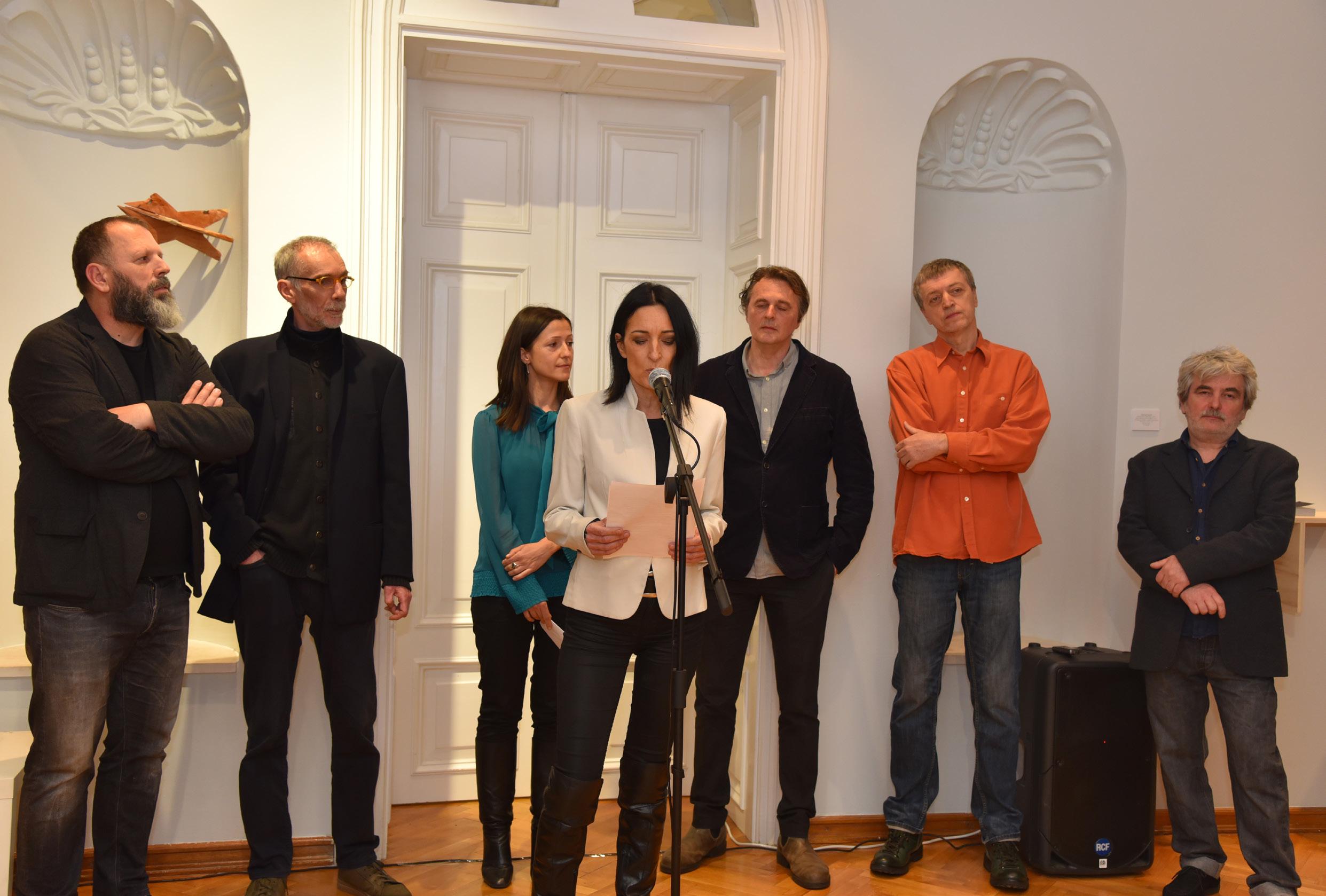
Izloženi radovi, pored distinktivnog, individualnog karakterističnog za vreme i mesto, u sebi sadrže likovnu, misaonu i ličnu povezanost ovih umetnika. Svaki od ove četvorice umetnika poštuje umetničku slobodu podržava individualnost izraza onog drugog. Svaki od njih najbolje poznaje rad, talenat, htenja, želje i namere onih drugih; oni su jedni drugima najbolji kritičari, mentori, asistenti i pomoćnici, ali nikad rivali.
Umetnici Srđan Apostolović, Zdravko Joksimović, Dobrivoje Krgović i Dušan Petrović, iako formalno ne čine umetničku grupu, to zapravo jesu. Izložba “4/prostor 4” ostavlja nama kao publici u zadatak da otkrijemo tu kreativnu crtu koja spaja ove umetnike, da uočimo koje su moguće, a koje ostvarene veze između njihovih praksi da identifikujemo načine na koje oni sebe povezuju i stavljaju u poziciju u kojoj se nalaze. Izložba baca novo svetlo na kreativno prijateljstvo ove četvorice značajnih umetnika koji se međusobno poštuju, ohrabruju podržavaju u svojim umetničkim istraživanjima. Jednostavno rečeno – ona je dokaz da Srđan Apostolović, Zdravko Joksimović, Dobrivoje Krgović i Dušan Petrović jedni druge čine još boljim umetnicima.
Srđan Apostolović Multi perfect 2016, 130x71x36 cm hrast/oak
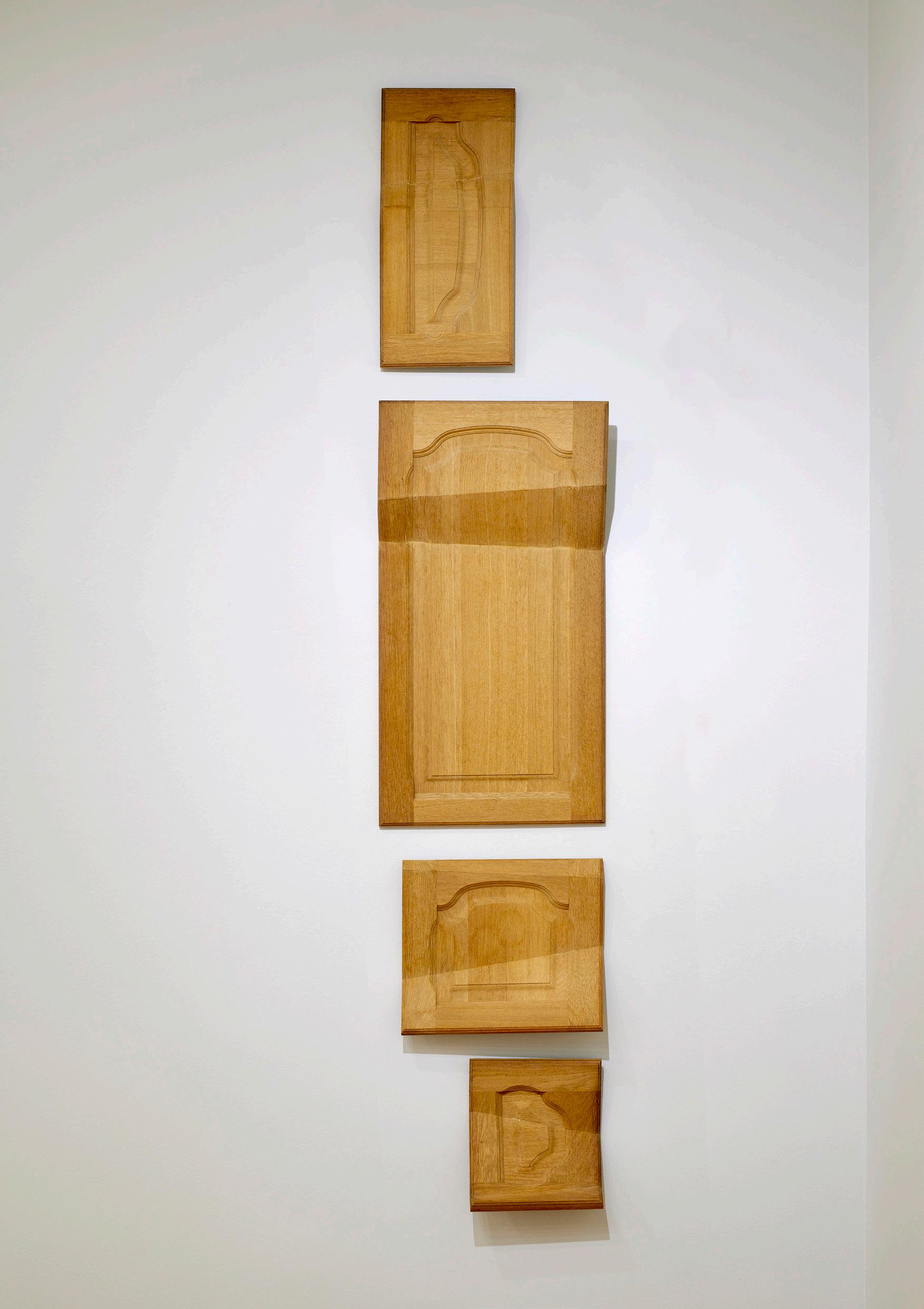
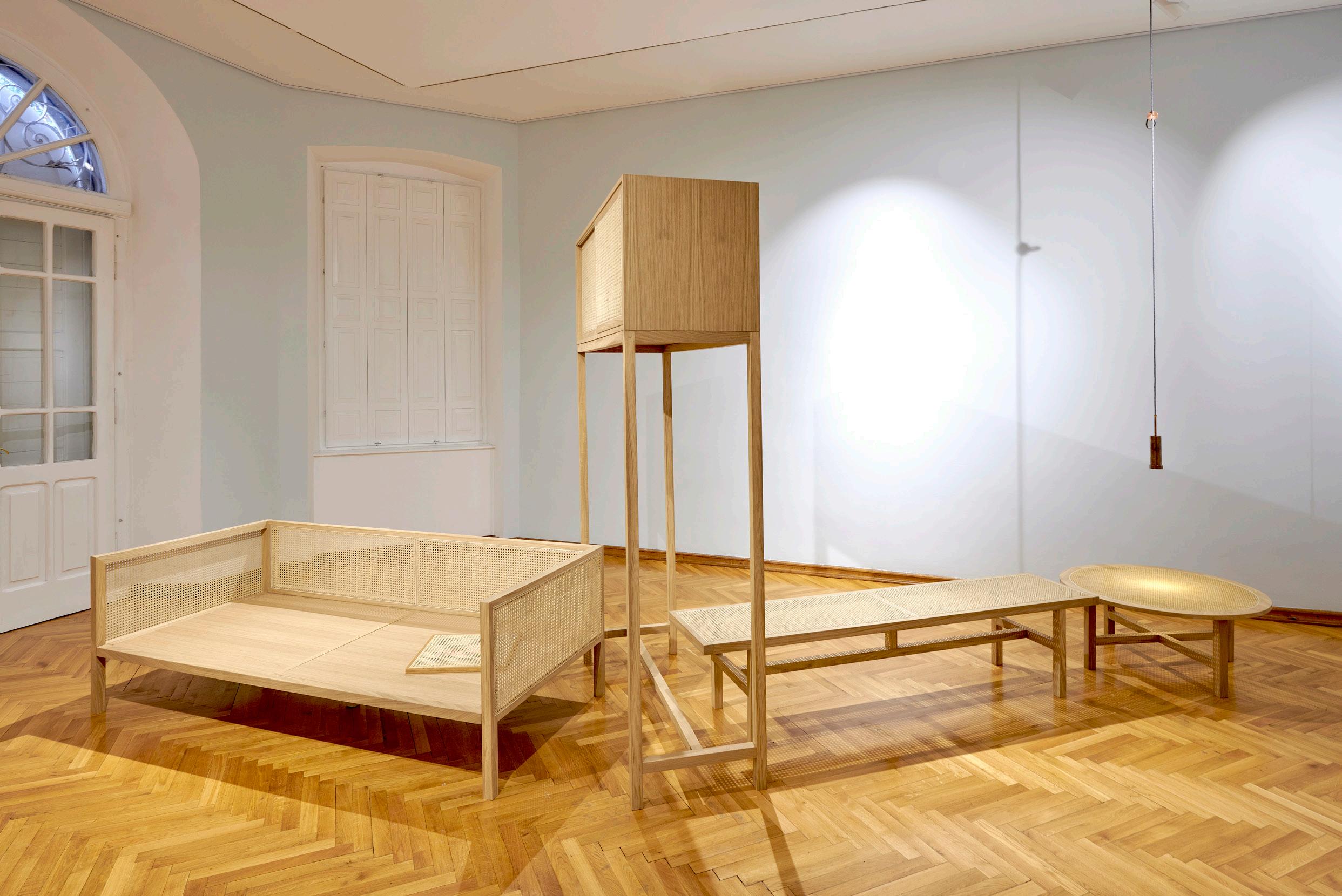
Aluminijum, neon, napojni kabal aluminium. neon tube light, power cable 52x22x20cm 2018.

 Srđan Apostolović Willkommen
Srđan Apostolović Pauza u ponavljanju / Break in repetition, 1998-2016, promenljive dimenzije / variable dimensions hrast, guma / oak, rubber (zid / wall) 4 x više snage / 4 x More Power 2016, 124x84 cm / papir, furnir / paper, veneer
Srđan Apostolović Willkommen
Srđan Apostolović Pauza u ponavljanju / Break in repetition, 1998-2016, promenljive dimenzije / variable dimensions hrast, guma / oak, rubber (zid / wall) 4 x više snage / 4 x More Power 2016, 124x84 cm / papir, furnir / paper, veneer
Srđan Apostolović Pauza u ponavljanju
Break in repetition, 1998-2016, promenljive dimenzije variable dimensions hrast, guma / oak, rubber

(zid / wall)
4 x više snage
4 x More Power, 2016, 124x84 cm / papir, furnir paper, veneer
Zdravko Joksimović
1000 x zato
1000 x Because 2016, 78x47x4 cm drvo, metal / wood, metal
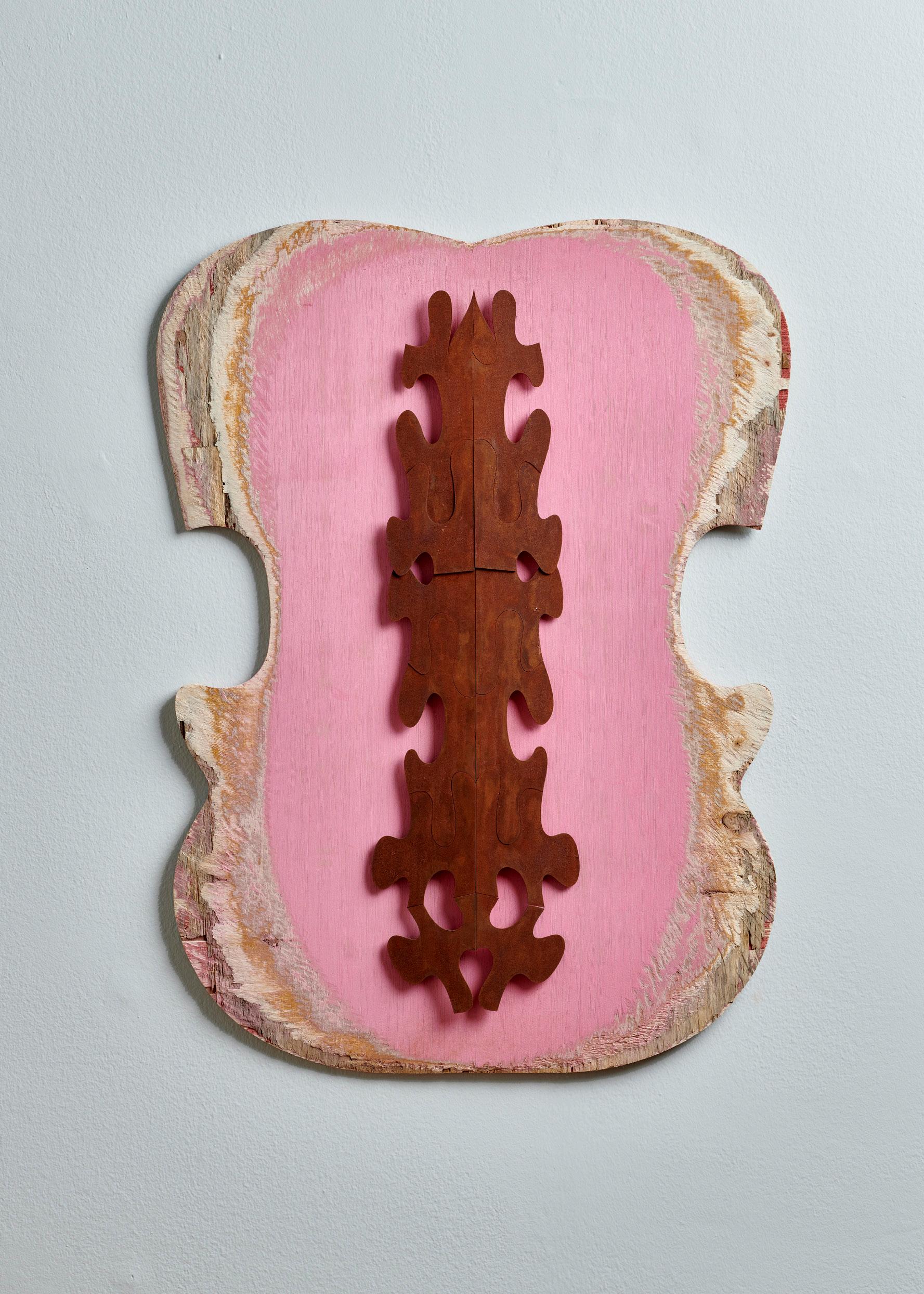
Zdravko Joksimović Živa ograda / Hedge 2018, 101x51x3 cm metal, guma, perje metal, rubber, feathers
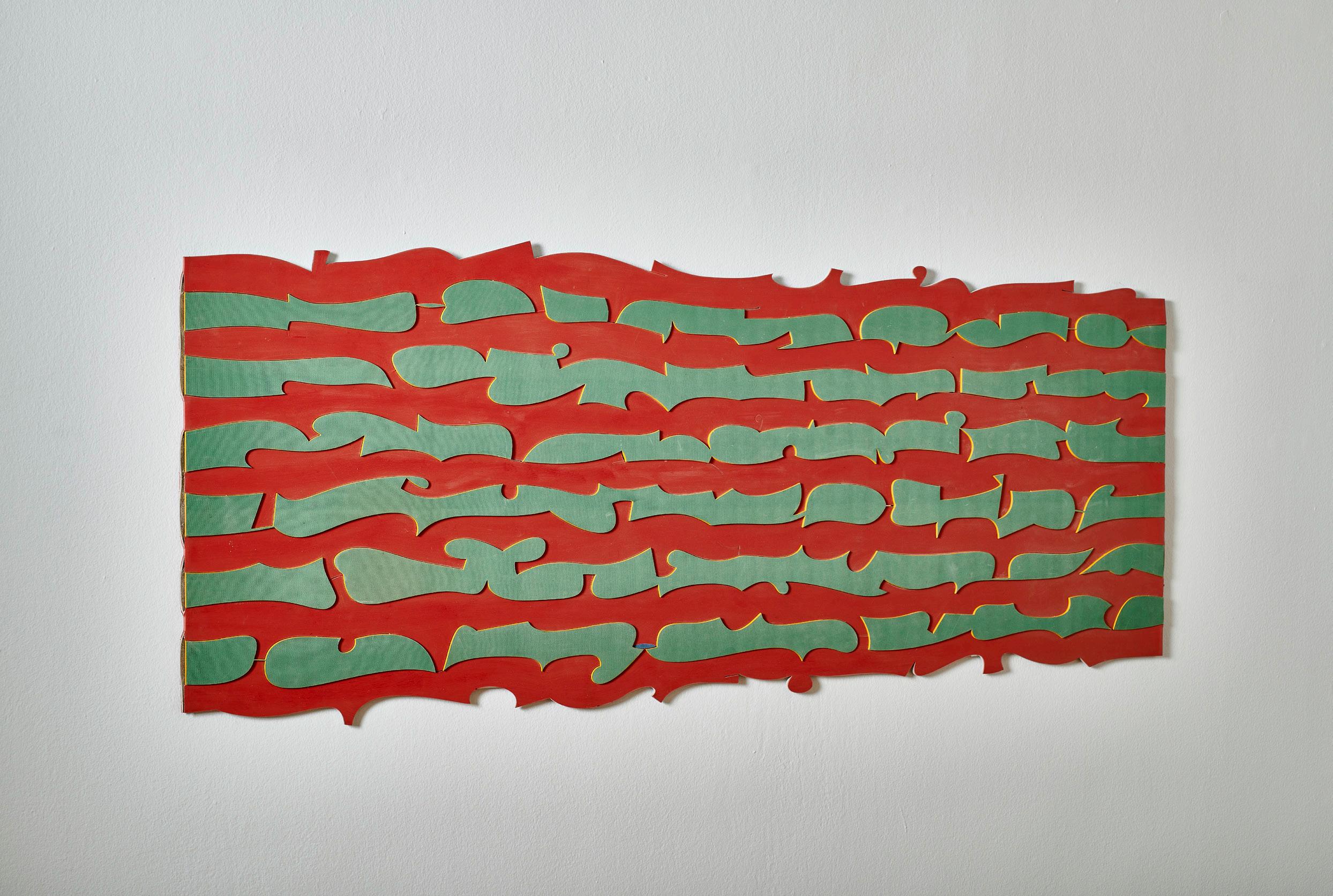

Zdravko Joksimović Ni početka ni kraja
There’s No Beginning and There’s No End, 2018, 75x190x1 cm guma, metal/rubber, metal
Zdravko Joksimović
Sad se sve vidi
Now You Can See It All 2015, 275x47x40 cm drvo, YTONG / wood, Ytong
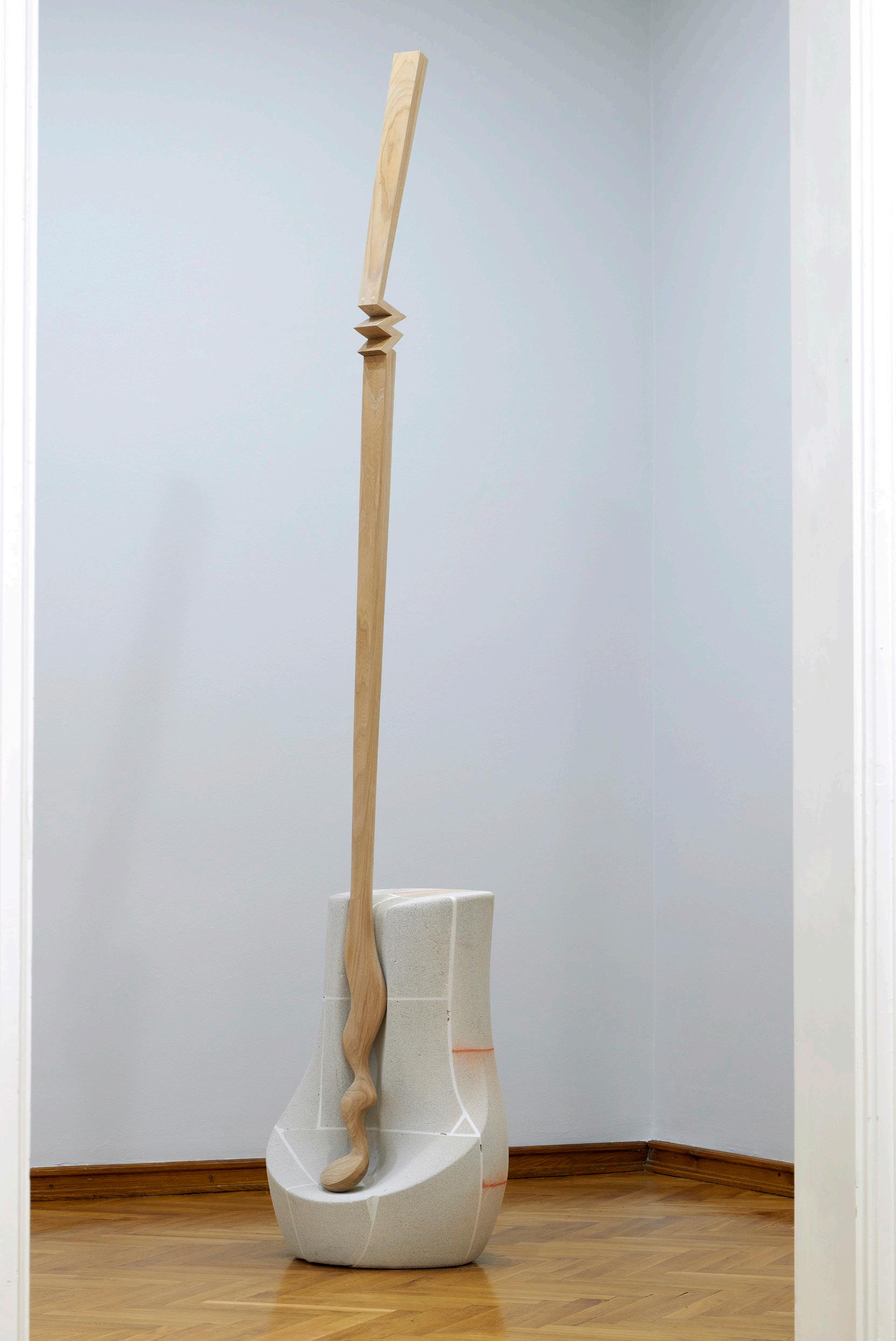
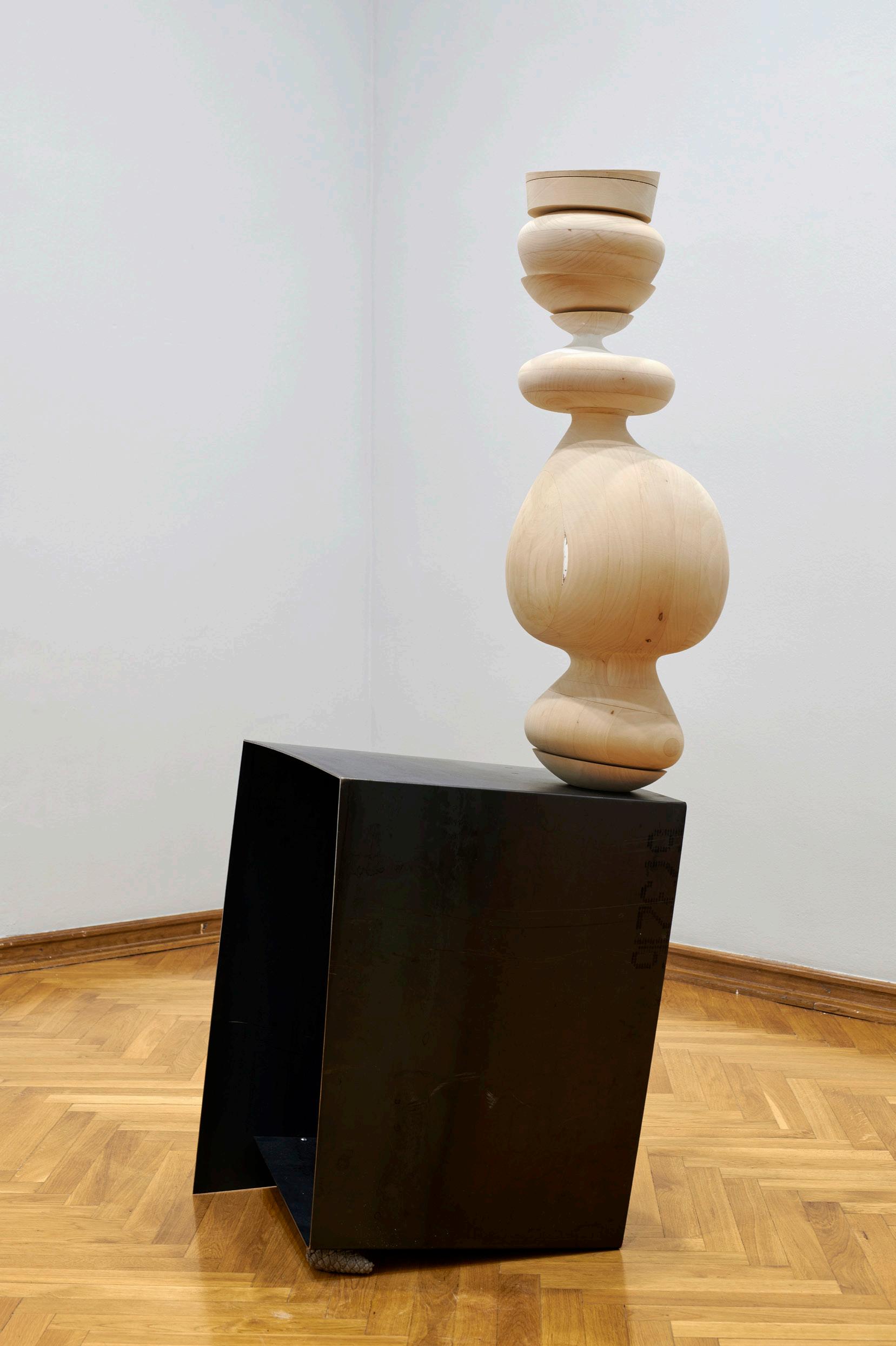
Zdravko Joksimović
Na mene uvek možeš da se osloniš You Can Always Lean on Me 2018, 177x55x51 cm drvo, metal/ wood, metal
Dobrivoje Krgović, Ivan Krgović
Noćni video / Night Video 2015

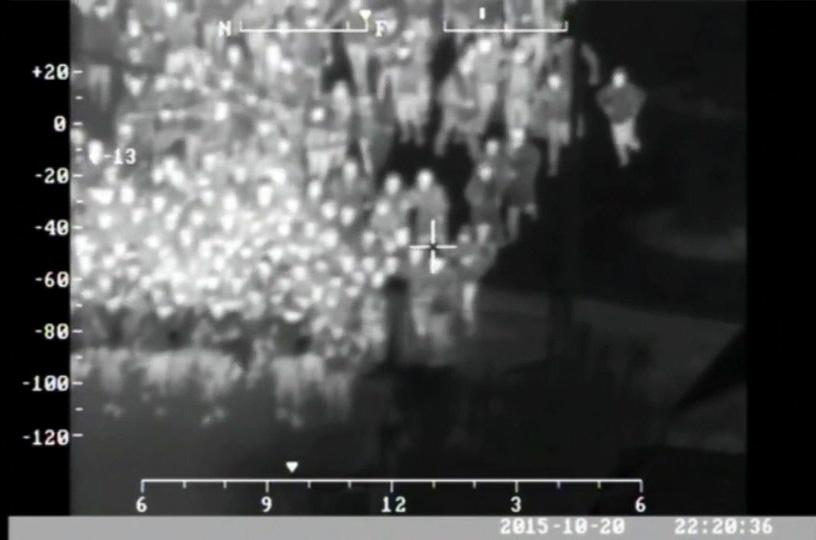
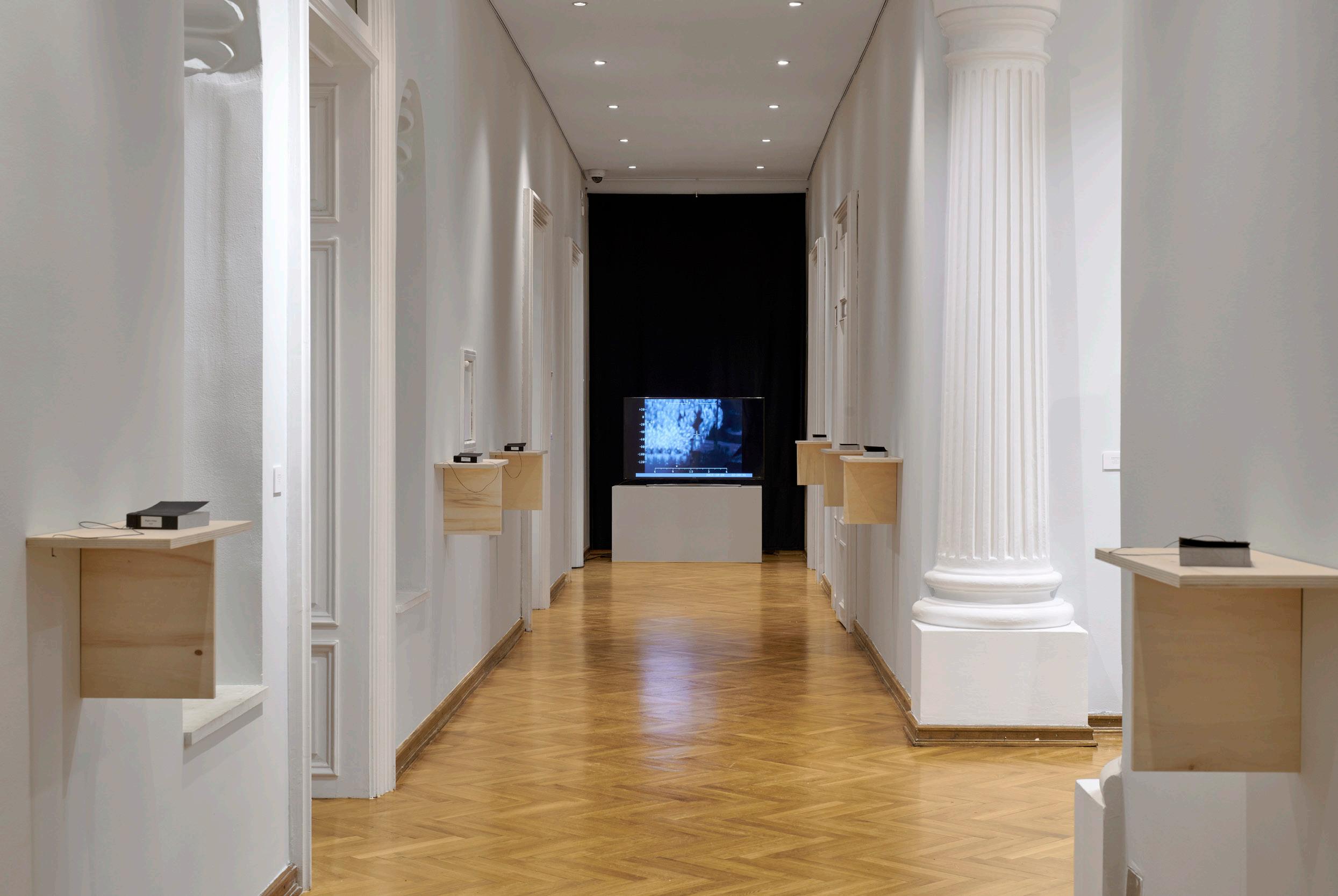
Video instalacija, dimenzije promenljive / video instalation, variable dimensions dokumentarni video snimak ”Nočni posnetek”, 6' 27" / documentary video ”Nočni posnetek”, 6’ 27” 7 flipbook-ova sa 14 animacija 5”, 25 fps, 16,5x10cm, 240 str. 7 flipbooks with14 animations 5”, 25 fps, 16,5x10cm, 240 pages.

Dobrivoje Krgović
A visit to New York, 2018.
Zvučna instalacija, dimenzije promenljive Sound installation, variable dimensions
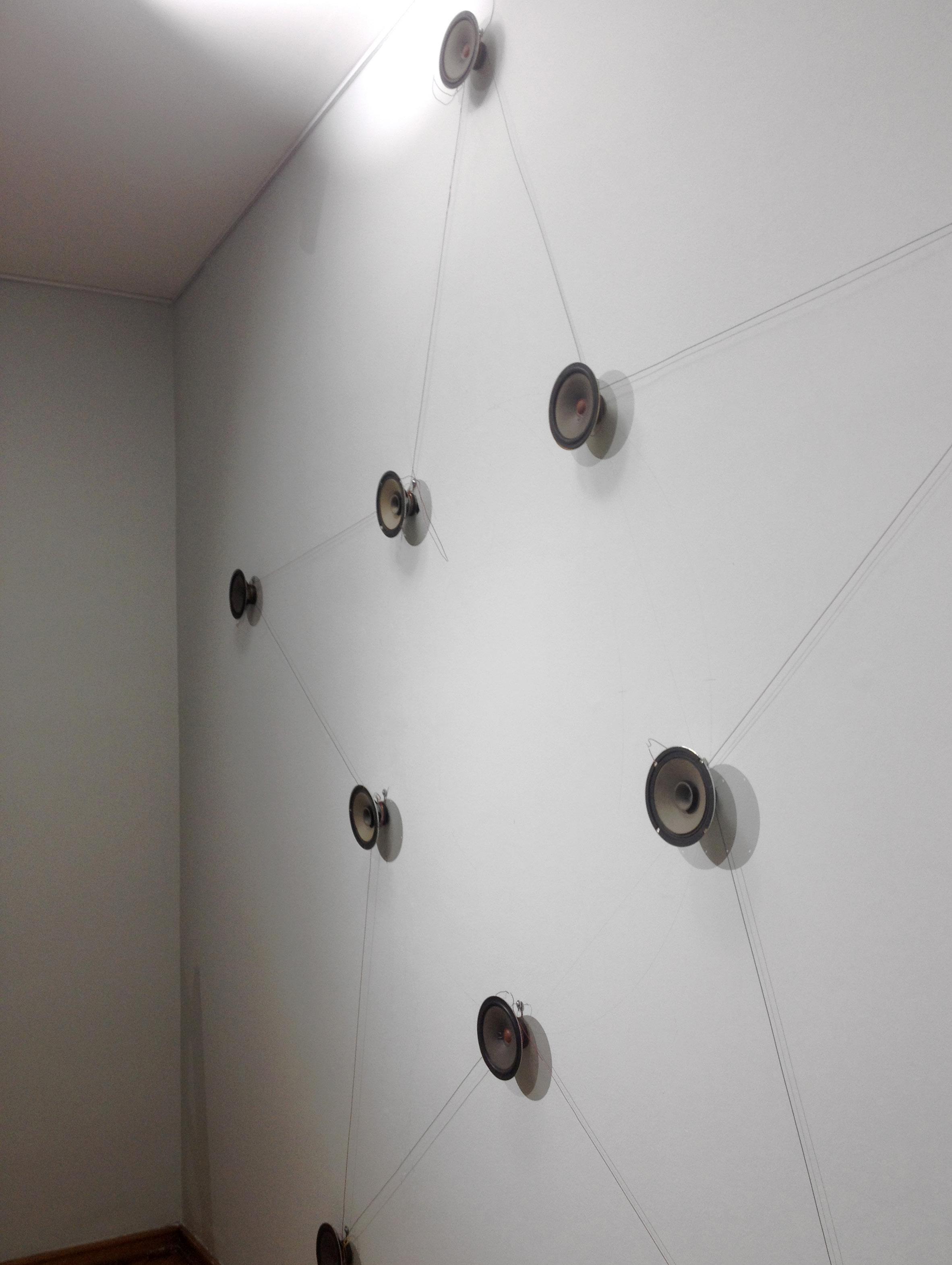
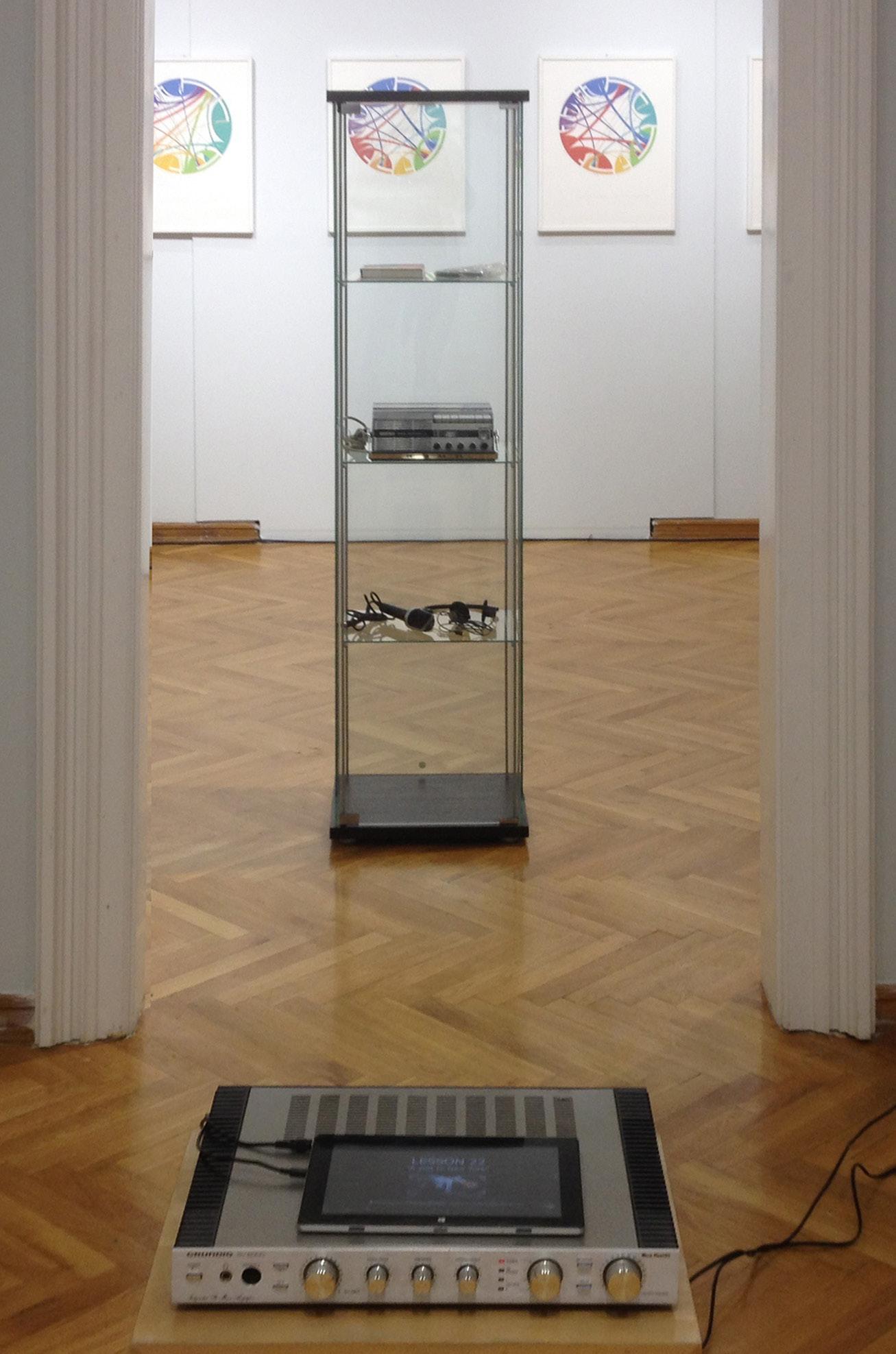
Magnetna traka “Philips” 5”/13cm, (Lekcija br 22, National Council of Teachers of English (NCTE), Proizvedeno: oko 1963)
Magnetofon UHER L4000L , Mikrofon UHER, slušalice Philips, 10 zvučnika EI Niš. / Audiotape “Philips” 5”/13cm, (Lesson No 22, National Council of Teachers of English (NCTE), produced around1963) Magnetic tape recorder UHER L4000L, microphone UHER, headphones Philips, 10 speakers EI Niš. (lični arhiv umetnika) / (artist’s personal archive)

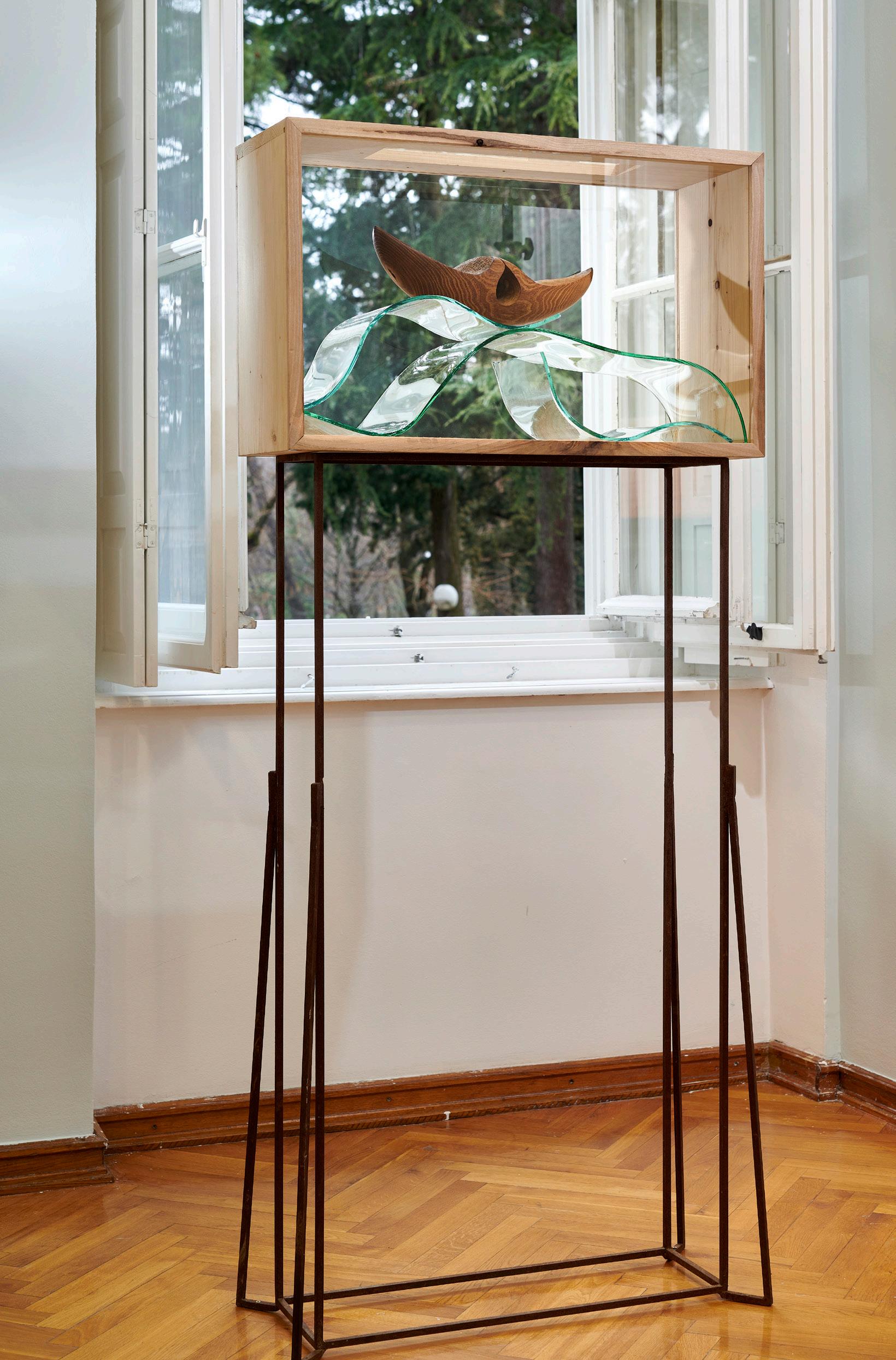
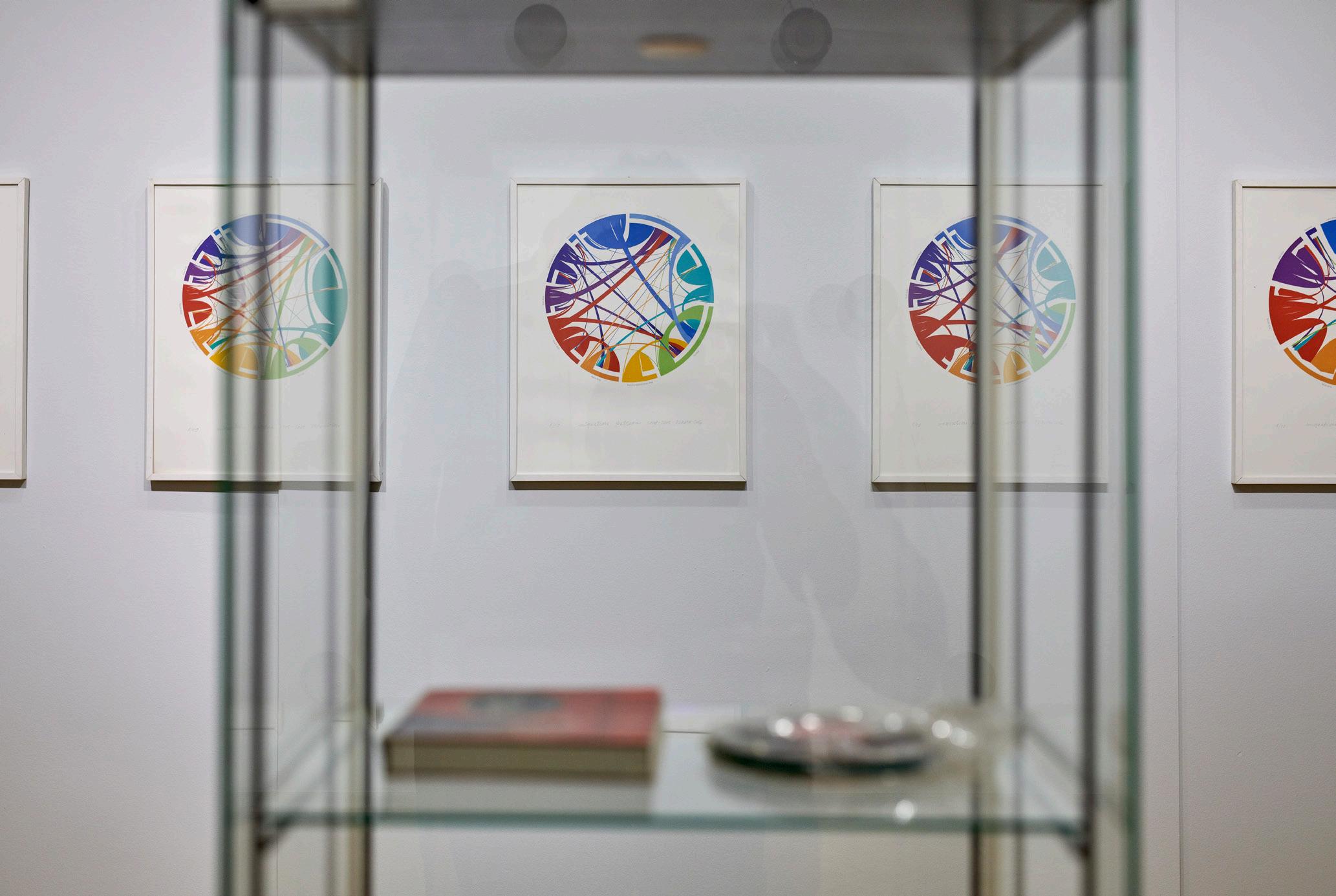 Dobrivoje Krgović Migration Pattern, 2018, digitalni print/digital print, 52x67 cm (x5)
Dušan Petrović Plovilo / Vessel 2016, 160x70x25 cm drvo, metal, staklo wood, metal, glass
Dobrivoje Krgović Migration Pattern, 2018, digitalni print/digital print, 52x67 cm (x5)
Dušan Petrović Plovilo / Vessel 2016, 160x70x25 cm drvo, metal, staklo wood, metal, glass
Dušan Petrović Letači Ii / Flyers Ii 2018, 130x120x60 cm drvo, aluminijum, mesing wood, aluminium, brass
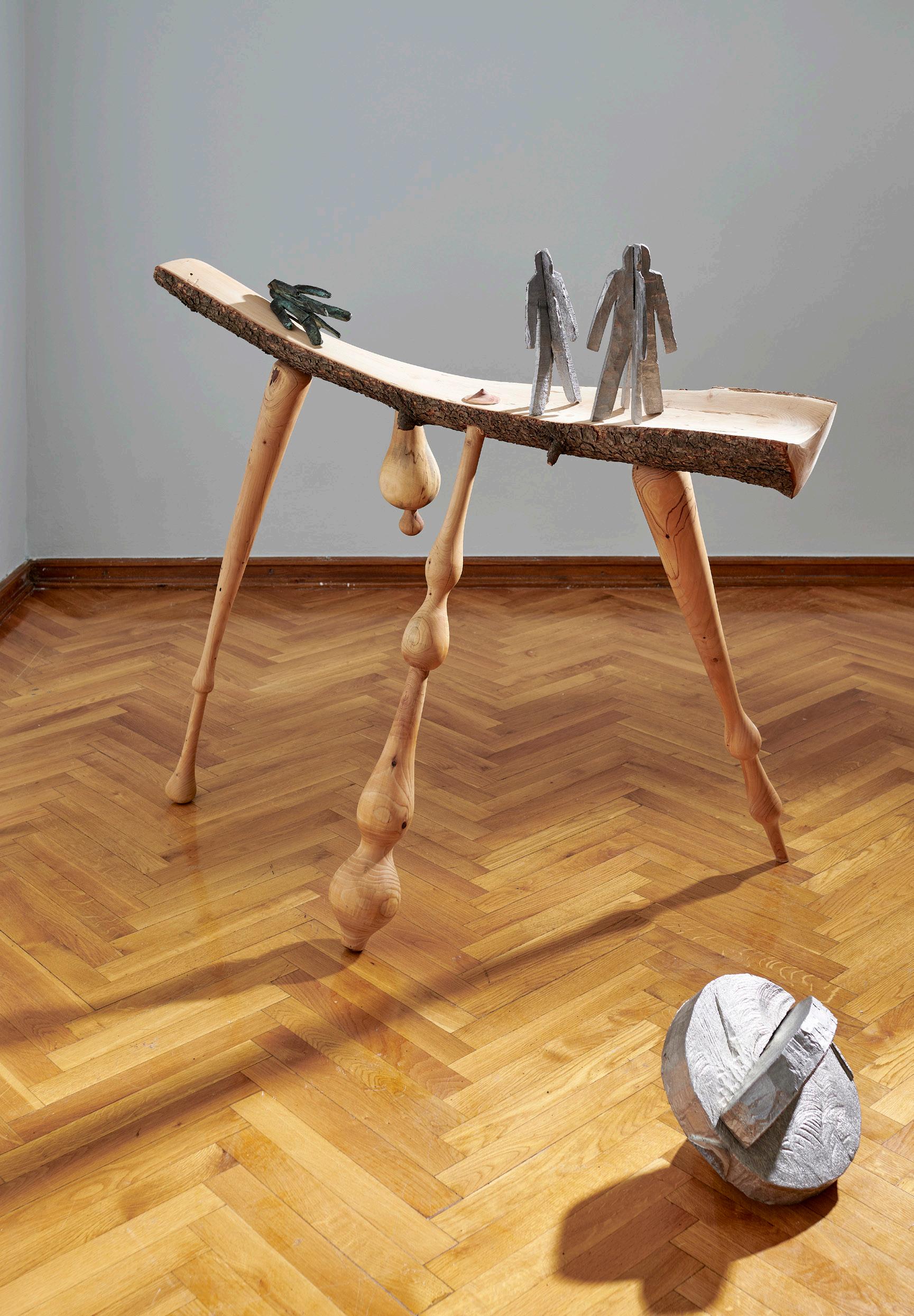
Dušan Petrović Letači I / Flyers 2018, 205x60x60 cm, drvo/wood
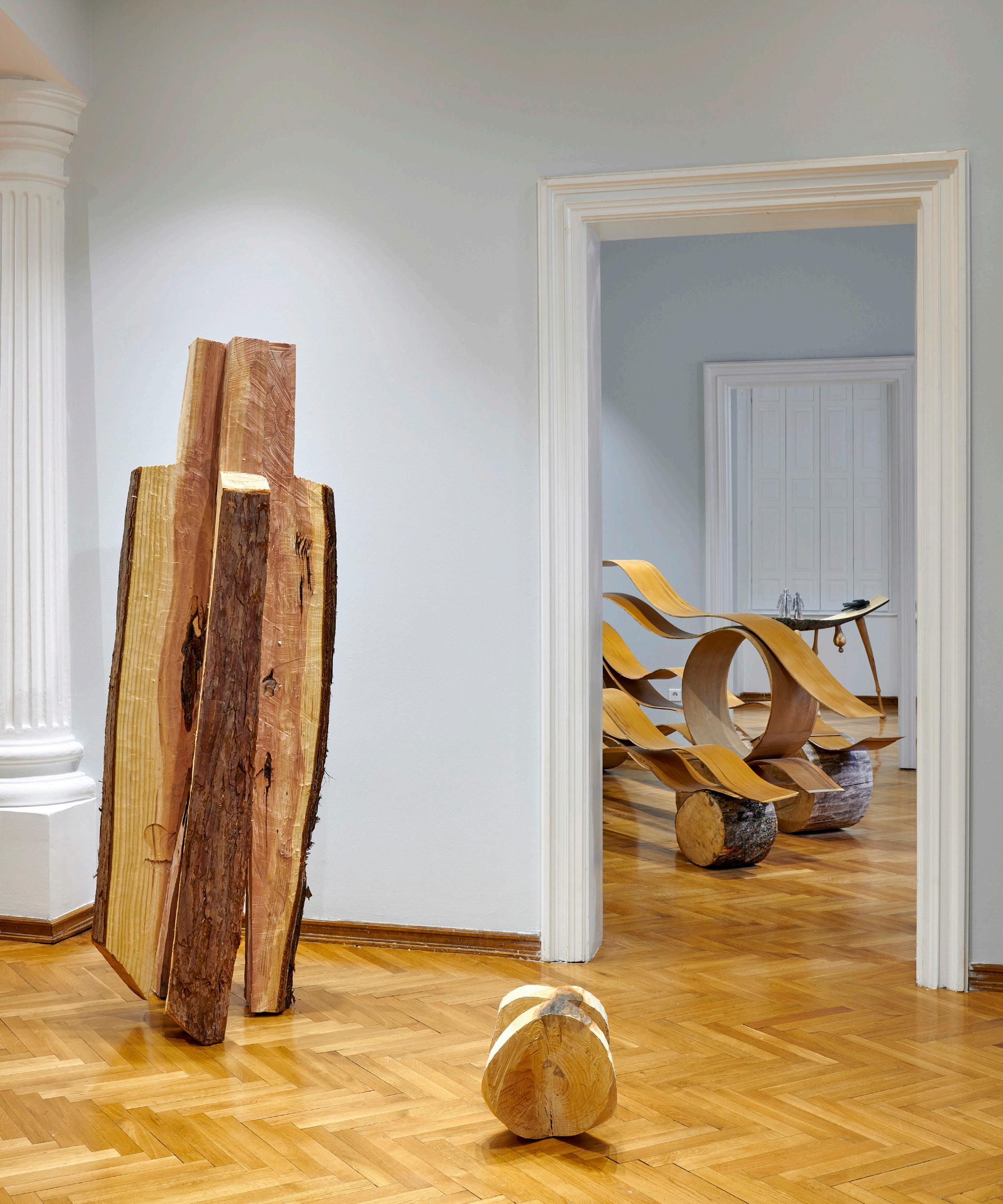
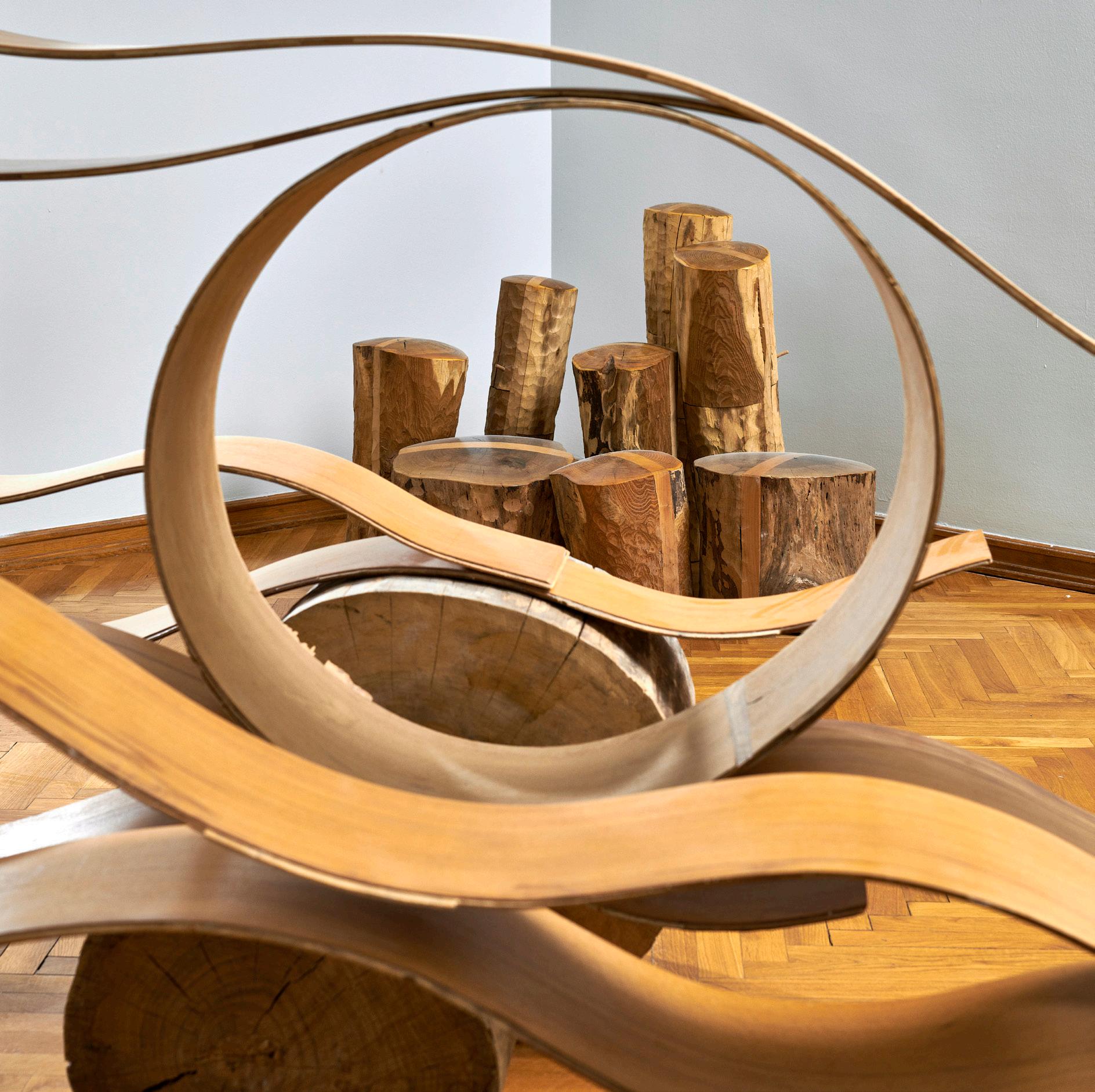
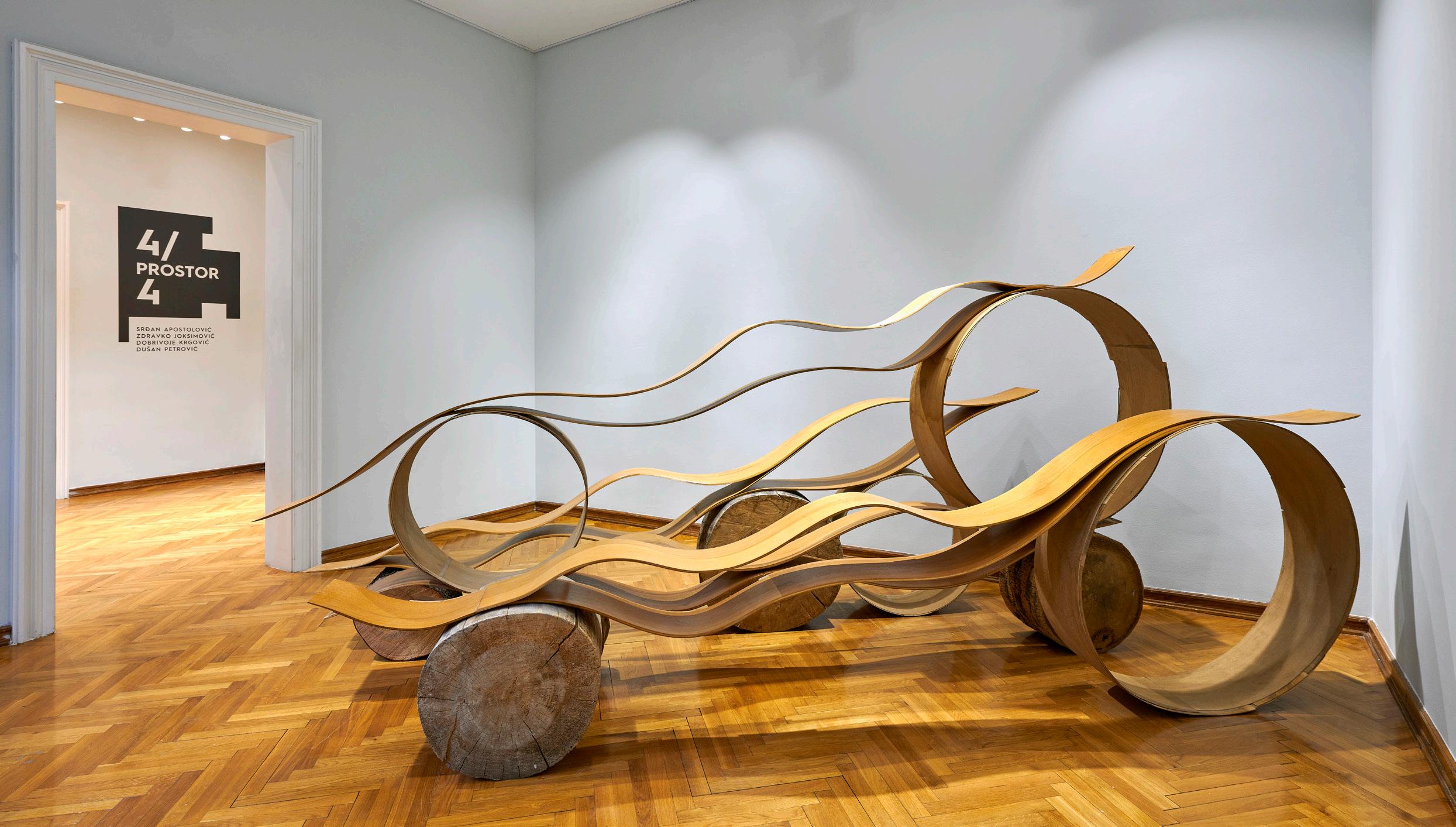 Dušan Petrović Buk/Rapid 2013, 92x180x400 cm drvo/wood
Dušan Petrović Buk/Rapid 2013, 92x180x400 cm drvo/wood
and setting the elements in the Multi Perfect installation (lining them up, moving them, and deciding on their direction and angles of expansion) open up diverse possibilities for harmonization between the installation and the space provided. The title is derived from an advertising communication.
The exhibition 4/space 4 presents to the Montenegrin audience four important artists – Srđan Apostolović, Zdravko Joksimović, Dobrivoje Krgović and Dušan Petrović. Their cooperation dates back to the late 1980s, when they gathered under the umbrella of the Art Workshop of the Student Cultural Centre Gallery in Belgrade. From that moment on, they have kept spending time together, exchanging ideas, experiences and thoughts about art, helping each other, and cooperating on various joint projects. Comparing their achievements with the New British Sculpture, art criticism gave them the name under which they are still known today in professional literature – the New Belgrade Sculpture
Their first group and solo exhibitions in the Belgrade Student Cultural Centre (SKC) were marked by the exploration of different forms of creative expression (such as minimalism, arte povera, sculpture in the expanded field, etc.). Then, as today, their artistic expressions were linked by a similar relation to the highest aesthetization of form, respect for the nature of the material used, a tendency towards reformulation and recontextualization, and an emphasized intellectual approach to the creation of artwork. Nevertheless, each of these four artists remained a distinct individualist, a strong creative personality with a distinctive artistic sensibility. Their joint exhibitions are extremely interesting because they represent a rare opportunity to see these artists’ works all in the same place, which provides us with a better perception of their mutual interactions that might otherwise remain insufficiently visible, hidden somewhere in the deeper layers of the artworks.
By the mid 1990s, SKC had provided them with a series of joint group exhibitions in the former state of Yugoslavia (in Belgrade, Zagreb, Dubrovnik, Sarajevo), but also abroad (in Paris, Strasbourg, Bari, Lisbon, Budapest), which is proof of the incredible success and artistic swing of these, then young artists; a success that was halted by the war and the general crisis of the 1990s.
Although in the second half of the 1990s they went off their separate ways in terms of artistic creation, they did not stop socializing and cooperating intensely. Their first group exhibition, organized after an almost two-decade-long break in 2011 at the Heritage House in Belgrade, resonated strongly with both the audience and the art critics. The next group exhibition was organized just as successfully at the Zenit 4 space in Novi Banovci in 2015, and was followed by the artists’ decision at the end of 2018 to organize further exhibitions in order to present new works to the audiences in the region.
Srđan Apostolović – desire for perfect form
Srđan Apostolović exhibits works that rely mainly on the highly aesthetized forms/elements characteristic of interiors, which the author then turns into autonomous works of art. This “furniture” (which is actually not furniture), a “heater” and the reformulated parts of a wooden door, are set by the artist in a distinctive context thanks to the establishment of fresh interactions between these elements, as well as the interactions between them and the surrounding space, thus providing them with an alternate modus vivendi and modus operandi through a wide range of potential relational meanings.
The Multi Perfect wall installation consists of wooden elements that evoke profiled parts of antique doors. Apostolović performed an artistic intervention on each element, breaking its surface at different angles to achieve the effect of “distorted mirrors”, or of a water reflection. In 2015, the artist performed a similar installation, a floor variant composed of a number of elements. The numerous ways of manipulating
4xMore Power is a polyptych that consists of four equally sized works, executed in techniques of incrustation/inlay of veneer into paper. The works can be exhibited individually, but on this occasion the artist has chosen to present them as an autonomous ensemble in the form of a tetraptych. The conceptual foundation that links these four variations on the same theme is the visual manifestation of the beginnings of the gaming culture in the 1980s. Through the artistic process, Apostolović modified the characteristic angling of the drawings at 45 and 90 degrees, thereby creating new imaginative motifs. The nobility of the veneer, the sharp geometric contours, and the whiteness of the paper create an interesting composition in which the dynamics of the veneer expansion in different directions is balanced by the calm whiteness of the background. The title of the work reflects the contemporary marketing jargon.
Break in Repetition represents one of the possible variations of the art installation as a product of an artist’s experiment with the combination of two different elements created over a span of 20 years. The title of the work points to the countless different creative ways of combining these objects. Apostolović positions the chair, made of black perforated rubber foot mat, inside the space by turning it upside down, thus revealing to the observer its lower part – a wooden construction with legs stretching high up. The unusual angle of observation and the creation of an alternative situation do not impair its artistic measure, but contribute to the appeal and visual conformity of the objects. This structure expands visually towards a semi-dome object that partially covers it; akin to a “shell”, and defined by its full and empty parts – bands of glued oak veneer and their mutual spacing. Although the rectangular construction of the chair represents an antipode to the arched veneer of the semi-dome, they are united by the same colour of the oak tree. Under the lighting, the shadows created by both elements form an integral part of the visual manifestation of the installation.
The work Willkommen conveys the experience of readymade and pop art. Apostolović uses the original antique aluminium bathroom heater on which he performs an intervention, replacing the real heater band with a red neon tube, very similar in colour to the original heater band. The artist complements the work with a pun in the title, which can be understood literally as a warm welcome, but also as an ironic invite, given that the heater can also burn.
I Don’t Hate the Superficial is a spatial installation of four elements – a round club-table, a bench, a dresser with overly high legs and an oversized sofa made out of rattan and wood. Although at first glance the objects appear as ordinary furniture, we soon realize that something “does not add”; dimensions and the layout are “wrong”, “unfitting”. Relying on his great experience in interior design, Srđan Apostolović re-contextualizes the purpose of the furniture, intervenes in their proportions, sets the elements into new relations and creates an artistic installation of an autonomous logic and existence. The installation includes a minimalist bulb-and-cord lamp that sheds light on the smallest item, the club table, from the top, accentuating it and bringing it into balance with the rest of the setting. The second detail is a framed rattan square placed on the sofa, with a barely visible writing “HILFE” (“help” in German), which illustrates the artist’s sense of humour as a reaction to the dilemmas that appeared during the creative process of this installation’s making.
Apostolović’s scrupulous attitude towards surfaces, shapes, materials and colours contributes to the visual appeal of his artistic practice. His unerring sense of the artistic measure of the distinctly defined surfaces and dimensions leads to his insistence on absolute purity and clear definition of the form. Srđan Apostolović is telling a story through shape and rhythm of the demarcated surfaces, colour, tactility, and a carefully coordinated relationship between the elements of the composition. Even though they are means
of narration, his works are brought to such perfection that they appear almost auto-referential, as if the perfection itself transforms them into autonomous artistic entities. The ambiguous titles of the works, at the same time literary and ironic, emphasize the importance of the point of view and the language of the artist’s visual narrative and denote the simultaneous existence of both the “ordinary” and the inverse reality of his works.
Apostolović places objects in an environment by considering its properties, as well as the properties of the objects themselves; a work is set only once it achieves the interplay of space and objects in a way that provides an added quality, striving for the postmodernist Gesamtkunstwerk.
Zdravko Joksimović - “There isn’t much mystification; what is set before you are the signs that we interpret on a daily basis, and therefore can read easily”
Sometimes harsh but never brutal, Zdravko Joksimović is a focused and analytical artist. He is known for his examinations of different combinations, where he makes free visual interconnections between many terms, and integrates them through metaphorical and metonymic approaches (figures of speech that use words in a figurative meaning; linked to the initial concept by similarity, in the case of metaphor, or by logic, in the case of metonymy). Joksimović’s works are also characterised by funny or puzzling titles that are just as important for the perception of his artistic practice. In the exhibition 4/space 4, the artist exhibits two older and three new works. This striking combination of colours and materials, as well as its superior execution, has represented a key feature of Joksimović’s artistic practice since its very beginnings.
Now You See It All, a work from 2012, represents Joksimović’s re-imagining of a straw inside a glass with liquid. The wooden straw can be visually divided into quarters: the upper part is slightly tilted and expands to the next zigzag, sharp-angled fraction; the lower quarter, slightly wavy, depicts the visual refraction of the object inside the liquid. The upper part of the “straw” is demarcated with a geometric sharpness, while the lower one transforms into a soft, curvilinear form. Joksimović shows the rounded “glass” in cross-section, with a convex inner (front) and concave outer (rear) side; the body of the “glass” is fragmented with white and brick-coloured bands that stand at right angles. Formally speaking, each part is designed to have its own opposite, with which it achieves an elegant, unobtrusive balance.
The work Now You See It All depicts the baring of the truth, a view from the inside of how things actually work – a confrontation between illusion and reality that happens in front of the observer.
1000 Times Because (2015) shows a stylized metal “spine” segment on a wooden surface in the form of a pink violoncello. The roughness of untreated edges of the work, the intensity of its shades of pink, and the grooves of a straight “spine” open up different ways of reading of its hidden narrative poetics.
The work You May Always Lean on Me, created at the end of 2018, combines an abstract sculptural wooden form with a dark metal cube pedestal that is created by bending a metal sheet. Everything appears slightly anomalous – the shapes and joints, the positioning of the object on the pedestal, as well as the pedestal itself. It looks as if everything stands intently in the only possible position that could provide a fragile balance of sorts, so that the slightest movement could knock the ensemble out from this delicate equilibrium, resulting in its collapse. The awareness of the tension between what may happen and the expectation of whether it will actually happen, secures that the observer’s attention is increasingly focused on the exhibited object.
Without Beginning or End is the name of the wall work executed in red and green rubber that had been cut in curvilinear bands, which fit one into another. The artist raises the green surfaces above the level
of red rubber, thus making way for colouring its outlines and emphasizing the work’s linear attributes. Although, at first glance, this completely abstract work acts as interplay of form and colour, Without Beginning or End is actually an ode to the line, to its exciting rhythms and the expressive possibilities that it provides.
In the work Living Fence, Zdravko Joksimović opts for metal and rubber. The gray rubber’s flip side creates the base and the backdrop of the entire wall composition, while the green rubber comes into view through the curved lines of the cropped and etched metal sheet. Certain oval parts of the partially cut metal are pushed to the front, and the shadows thrown by the metal sheet on the green and gray rubber substrates contribute to the sophisticated tonal gradation of the composition, while one detail – a cyclamen-coloured feather – playfully interrupts its calm colouring.
The works Without Beginning or End and Live Fence, from 2018, represent the continuation of the artist’s research inspired by the painting practices of Bora Iljovski. Nevertheless, unlike Iljovski’s paintings, which do not have a focus on the composition, Joksimović’s Living Fence does; in the title of the work, Joksimović also creates a reference to the manifest world, as well as the interplay between its literal and figurative meaning.
Joksimović retains the linguistic autonomy and complexity of Iljovski’s artistic expression, transposing it to the third dimension – from the level of painting to the space of sculpture. First with restraint (Without Beginning or End), and then more freely and experimentally (Live Fence), Joksimović reaches for the postmodernist citation of the authentic visual manifestation of Bora Iljovski’s compositions, building on this foundation original, decorative and ornamental formalistic compositions of a recognizable, unique sensibility. Humour, most often in the form of irony and occasionally of sarcasm, is a modus operandi in both the life and the artistic practice of Zdravko Joksimović. As in a successful pun, where the ending never follows the logical sequel we expected it to do, the titles of Joksimović’s works of art reveal an entirely new, unexpected, yet totally vivacious dimension of his artistic expression.
Although artwork titles are also important complements of the other three artists’ poetics, they are almost crucial for Joksimović’s work, given that often without them we would not be able to take in his visual poetics in the right way. Zdravko Joksimović believes that the titles of his works function as their “names and surnames”, in other words – as vital parts of what defines them.
As professor at the Faculty of Visual Arts, Joksimović is very familiar with the application of semiotic theory to artistic creation. He uses both visual and linguistic semiotics to combine the potentials of objects, shapes, materials, and colours with words that describe them and words from the work’s title, mining them all for unexpected novel meanings. The artistic production of Zdravko Joksimović is heterogeneous and imposing: by creating in cycles, the artist visualizes new ideas, uses different approaches, materials and techniques until he satisfies his curiosity and switches to the following cycle. Although, over time, Joksimović’s art practice has changed both formally and in terms of genre, his artistic sensibility has remained fully recognizable.
Dobrivoje Krgović – “The over-exploited sources don’t represent a simple reproduction of already known facts, but the space of potentially new narratives and source of new meanings.”
Concerning the conceptual foundations of the works exhibited, Dobrivoje Krgović asserts that he “takes the found and appropriated audio and video recordings which, in the form of documentary material traces, are subject to re-reading and re-relationing. These relations, once established,” the artist adds, “do not have to be final; it is all about unfinished projects that open new visions.”
Night Video, an art installation co-authored with Ivan Krgović, consists of two parts: the first one is a soundless original video of a Slovenian border police patrol, recorded by a thermographic camera. The video shows hordes of “white” human forms briskly walking or running through the streets and fields in full darkness, trying to cross the Croatian – Slovenian border. Krgović found the video at 24ur.com, and took it over from YouTube, a social media site that has been increasingly taking on the role of a legitimate information service. The second part of the installation consists of seven identically designed flip-books - “moving images” with selected 5-second original video sequences. In this way, the artist deals with the theme of migration as a proto-narration that unifies two different ways of image projection from two remote time periods, linked by logical and semantic connections. They combine today’s most sophisticated technology (a recording made by a thermographic camera) with the first motion picture ever produced (a flip-book).
The original context of the footage is documentary / informative, intended for border police control; its uploading to 24ur.com and YouTube gave it a different informative context – the intention of informing the general public about the developments in the movement of migrants across the borders of the countries of the European Union. The already re-contextualized recording of very touching events is then changed for the third time, in contextual terms, by its inclusion in an authorial art installation.
The migrants shown on the video appear white, akin to ghosts, to people who are not here, people who do not exist. It is only when a visitor takes a flip-book into his hands and starts animating its images, that the migrants, their problems, and destinies become tangible, real and present; not just out there somewhere in the distant world, but right here in front of our eyes. “The tension that occurs in the wake of such connection becomes literally tangible, given that the animation of these touching images takes place literally in the hands of the spectators themselves,” says the artist.
The topic of migrations is also present in the work titled Migration Pattern, created by the artist at the invitation of the Centre for Graphic and Visual Research for their prestigious 2018 calendar. Drawn by the results of the Circos computer software created for graphical visualization of statistical data, Krgović uses the generated migration patterns and intervenes on them during post-production, while retaining the relative interactions of population shifts in the world. The displayed ensembles are dominated by vibrantly coloured circular forms representing the geo-politically defined parts of the continents; the arcs show the directions of population migrations; while the arcs’ width corresponds to the percentage of participation of each geo-political entity in the migration. The Migration Pattern series consists of five works that show data grouped into five-year intervals, from 1990 to 2015. Neither here nor in any other works does Krgović present final judgments or close the form, leaving them rather structurally open in order to enable a myriad of different readings. Migrations themselves may be voluntary or forced, economic, emotional, incited by catastrophes, etc. Visually, Migration Pattern at first appears “cheerful and colourful”, maybe even excessively playful. Nevertheless, we come to understand that it is a very sophisticated ensemble of similar forms in almost identical compositions, whose potential meanings are different from those purely statistical, and that the playfulness is just an “eyecatcher” that hides a much darker narrative.
Although on the face of it Migration Pattern might seem an antipode to the Night Video installation (staticity and rich colouring versus motion and the monochrome b&w), when juxtaposed within the same space, these works come together in a deliberate, systematically shaped visual entity.
Lesson 22 “A Visit to New York” is a sound installation composed of found artefacts from the 1960s: original tape recordings of the Foreign Languages Institute from Gospodar Jovanova Street in Belgrade, tape recorder, microphones and headphones, digitally copied lessons for English learning (by the National Council of Teachers of English – NCTE) and ten old round speakers placed on the wall in the shape of a five-pointed star. The artist states that “the structure of the contents of Lesson 22 is based on the principles of an audio-lingual method of foreign language learning that encourages the use of “drilling”
exercises originating from the so-called “military training method” (the ASTP method). The music integrated in the lesson, which represents at the same time historical fragments and specific documents, achieves an important function of introducing and familiarizing the listener with the system of cultural patterns.”
The visual focus of the installation is the five-pointed star on the wall, formed by the speakers positioned at regular intervals at the crossing points of the line that traces the star shape. The artist says that “the multiple symbolism of the star (or pentagram) offers a place open to different conceptualizations, which is also a source of many potential narratives.” Krgović does not put forward any “association” as necessarily true – there are no right or wrong answers in this game, only an incentive to create new possible narratives stimulated by the presence of the recontextualized artefacts.
Dobrivoje Krgović has distanced himself the most from the artistic practices of this group’s creative beginnings at the Art Workshop of the SKC gallery in Belgrade. As a perfectionist, he studiously and methodically devises and executes his works; and it was precisely his work called Floor-to-Ceiling Sculpture that has become the paradigm of 1990s Serbian art scene.
Dušan Petrović – “I try to make my work leave an impression on the viewer, so that it acts as a magnet; the impression it leaves depends both on the viewer and the work.”
Dušan Petrović is best suited for work with natural materials – wood, stone, as well as glass and metal. He brings out the greatest natural potential of each of these materials, regardless of the degree of his artistic intervention. Whether he polishes a piece of wood until it starts resembling amber, or minimally intervenes and leaves the wood almost untouched so as to emphasize the power of its natural presentation, the artist creates sculptural compositions that inevitably rouse strong emotions in the viewer.
In the exhibition 4/space 4, Petrović presents to the audience three new and one older work. In all four pieces, wood as a material plays the most prominent role. Most art critics have already noticed that his artistic sensibility is best demonstrated in his work with wood – Petrović is here “on his own turf”, playful, relaxed, inventive and innovative.
In Rapid, from 2012, the artist presents a river rapid executed in wood. This inspired re-evaluation, i.e. re-formulation of one natural material into another, tree into water, results in an extraordinarily powerful, striking work that is sure to never be forgotten. But Rapid is not only that – it is also a fantastic puzzle, a source of a potentially endless series of different combinations of four types of modules – large, broad stumps; high, narrow pieces of roundwood, constructional veneer circles and long wavy elements in polished constructional veneers. The tall pieces of roundwood are the most elaborated sculptural elements of the installation; Petrović incorporates a barely noticeable detail on their meticulously polished protruding top – a miniscule semi-precious stone that represents a drop of water, and connects these elements with the title of the work. Over the central part of the roundwood pieces, the artist places a lighter coloured band that continues along its sides, breaking the tonal monotony. By combining processed and unprocessed parts, he creates a particular rhythm for reading the artwork. Superbly designed, Rapid adapts to the space and the current inspiration of the artist, and is therefore always “new”, fresh and different.
Sculptures Flyers I and II are dedicated to pilots, defenders of Belgrade in 1941. The large sculpture Flyers I represents a visually stripped-down human figure made out of sequoia wood, which resembles a stylized rocket. Through the deliberately visible woodwork traces left by a chainsaw, we recognize the head and legs/supports of this human figure/rocket. The artist lets the observer’s gaze penetrate the depths of the sculpture, allowing us to see the “life” of the tree, its flow, the nodes and colour gradation ranging from
the dark bark, over the lighter layers underneath it, to the flesh-coloured insides. “The tree is always alive, as well as the sculpture,” Petrović says. The rocket/man is standing with four legs on the ground, ready to fulfil his duty – to shoot up high into the heavens and disappear.
Compared to Flyers I, the sculptural ensemble Flyers II is conceptualized in an entirely different way –three small metal sculptures (aluminium and brass) in different colours, representing flyers, are placed on a wooden arch foundation; its upper side is constituted by the polished insides of the tree, while the bottom is left untreated, with the bark. This arched pedestal stands on three wooden legs, which differ completely, formally speaking, from the rest of the composition. The painstakingly treated wood, with interlacing wider and narrower parts, resembles water drops or a spindle. The fourth “leg” is only hinted at; it “hangs” from the base and does not reach the ground. In addition to this primary composition, another part of the work is a coloured metal floor sculpture in the form of two circles that cut one through the other at a right angle and symbolize orbits. Flyers II rather recalls astronauts on a new planet – finally at their “goal” after a successfully accomplished task, in a different, parallel universe, in another dimension of existence.
The Vessel is Petrović’s postmodernist interpretation of popular painting compositions featuring a boat on the water. Here we see a box/container with wooden sides, while the front and back are made of glass; inside the box, as a separate part of reality, i.e. a world to itself, the artist piles several undulating glass surfaces one on the other (like water, waves), placing a “vessel” on the top – a piece of wood resembling a boat, with an oval opening in its upper central part through which we can see whatever is standing behind the rear window of the box. The box is placed at eye level on a four-legged metal base.
Two factors influence the change of the inner and outer landscape. The first is the environment, because the box acts as a window – it “appropriates” different environments, i.e. its immediate surrounding –and the other is our perception. Depending on the condition of our mind, we will either see thunderous sea and a boat fighting for survival, or the calm, idyllic boat-on-water scene. By re-examining the conventional concept of maritime landscape and the prejudices about the decorum of the portrayal of these scenes, Dušan Petrović opens the door to all possible meanings and untold narratives, handing them over to the context and to the audiences.
The author explains his relationship to material in an interview in which he states that artificial materials do not hold any appeal for him because they seem futile, empty; while he finds inspiration in wood, stone or glass: “they contain a form that I need to find out.” “The material is inspiring, and the idea is transformed during the creative process. If I do not follow the material, it means I go against it, so the work cannot turn out well,” says the artist.
Dušan Petrović has always insisted on the purity of his works in the formal, material, and artistic sense. He constantly anticipates the ways and methods in which the viewer’s gaze will reveal the visual integrity of the work. “I try to make my work leave an impression on the viewer, so that it acts as a magnet; what the impression will be depends both on the viewer and the work.”
setting alters the appearance of each space in which it finds itself. Integrating the works of these four artists into some sort of a “joint individual” exhibition, the setting of the exhibited works provides a complex shared discourse that draws the hidden quality of the works onto the surface and provided them with a different kind of insight. Each of the artists associates his works with all the other pieces that are exhibited. Contemporary Chinese artist Huang Yong Ping says: “We believe that one person should have only one way of thinking, but when you become a bridge, you must have two.” When setting up the exhibition, artists Srđan Apostolović, Zdravko Joksimović, Dobrivoje Krgović and Dušan Petrović do not have “only” two, but several mutually intertwining ways of thinking that connect all the works to each other through proto-narrative, formalistic, conceptual, philosophical, visual and conceptual connections. They do this with incredible ease, so unobtrusively; they are, as Joksimović points out – “just putting order into space”.
In addition to their distinctive individual characteristics and those related to place and time, the exhibited works also convey the artistic, contemplative and personal associations among these artists. Each of the four artists respects the artistic freedom and supports the individuality of the expression of the other. Each of them knows best the works, talents, needs, desires and intentions of the others; each of them is their best critic, mentor, assistant and helper, and never a rival.
Although Srđan Apostolović, Zdravko Joksimović, Dobrivoje Krgović and Dušan Petrović formally do not form an artistic group, in reality they do. The exhibition 4/space 4 leaves us, the audiences, with the task of discovering the creative line that connects these four artists. We are entrusted to see both the possible and the actual connections between their practices and to identify the ways in which they associate and put themselves in a position in which they are. The exhibition casts a new light on the creative friendship of four famous artists who mutually respect, encourage and support each other in their artistic research. Simply put, this exhibition is proof that Srđan Apostolović, Zdravko Joksimović, Dobrivoje Krgović and Dušan Petrović make each other even better artists.
„We are just putting order into space, nothing more”
The exhibition 4/space 4 displays the newer artistic production of four artists through the presentation of twenty of their artworks, of which more than half have only just seen the light of the day. Art critics have pointed to the influence of minimal art, arte povera and sculpture in the expanded field, but so far they have not looked into the mutual creative influence that these artists have on each other.
“We are just putting order into space, nothing more,” says Zdravko Joksimović. The exhibition’s
Izdavač / Publisher
Centar savremene umjetnosti Crne Gore
Contemporary Art Centre of Montenegro
Za izdavača / For the Publisher Nenad Šoškić
Kustos / Curator Ivona Fregl
Tekst / Text Ivona Fregl
Prevod na engleski / Translation into English Ana Savjak
Grafičko oblikovanje / Graphic design Anastasija Kostić
Fotografije postavke / Photos of the exhibition setting Duško Miljanić
Fotografije sa otvaranja / Photos from the exhibition opening Jovana Vujanović
Organizacija ART-ZOOM, Beograd / Project ART-ZOOM, Belgrade
Tehnička realizacija izložbe / Technical set-up of the exhibition
Novica Vuković, Rajko Raičević, Nebojša Raspopović, Nemanja Radević
Tiraž / Circulation 150
Štampa / Printed by DPC, Podgorica

